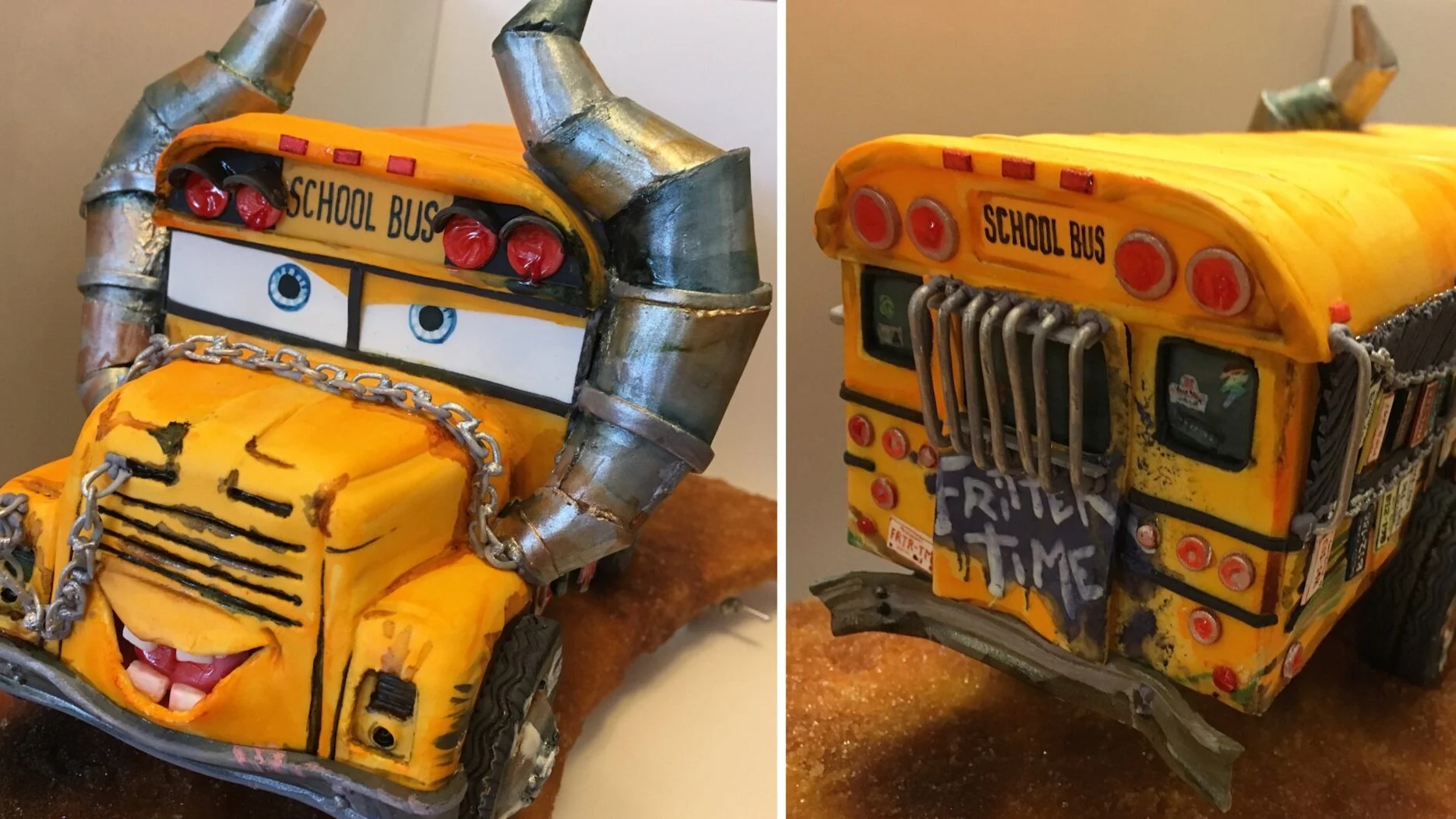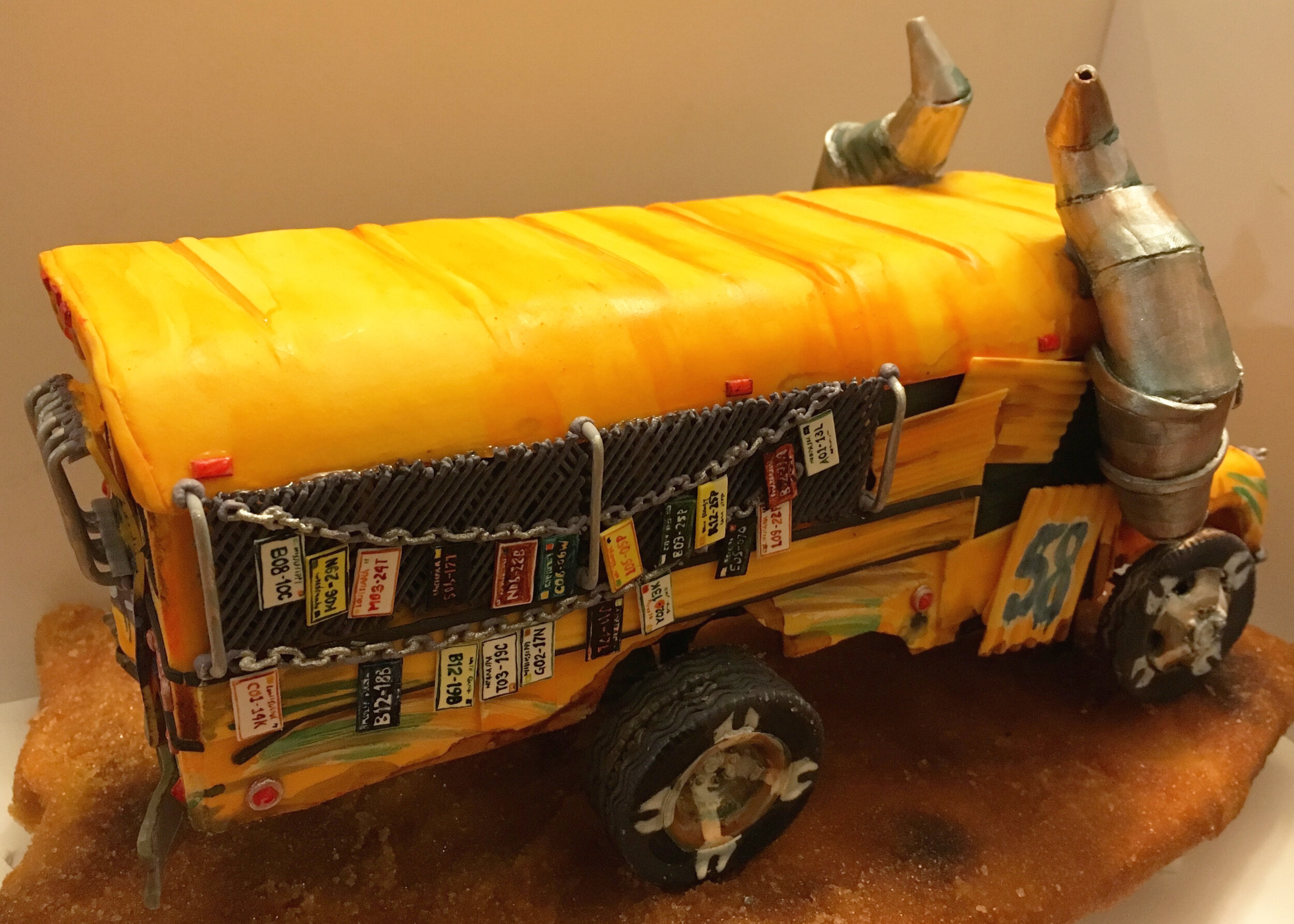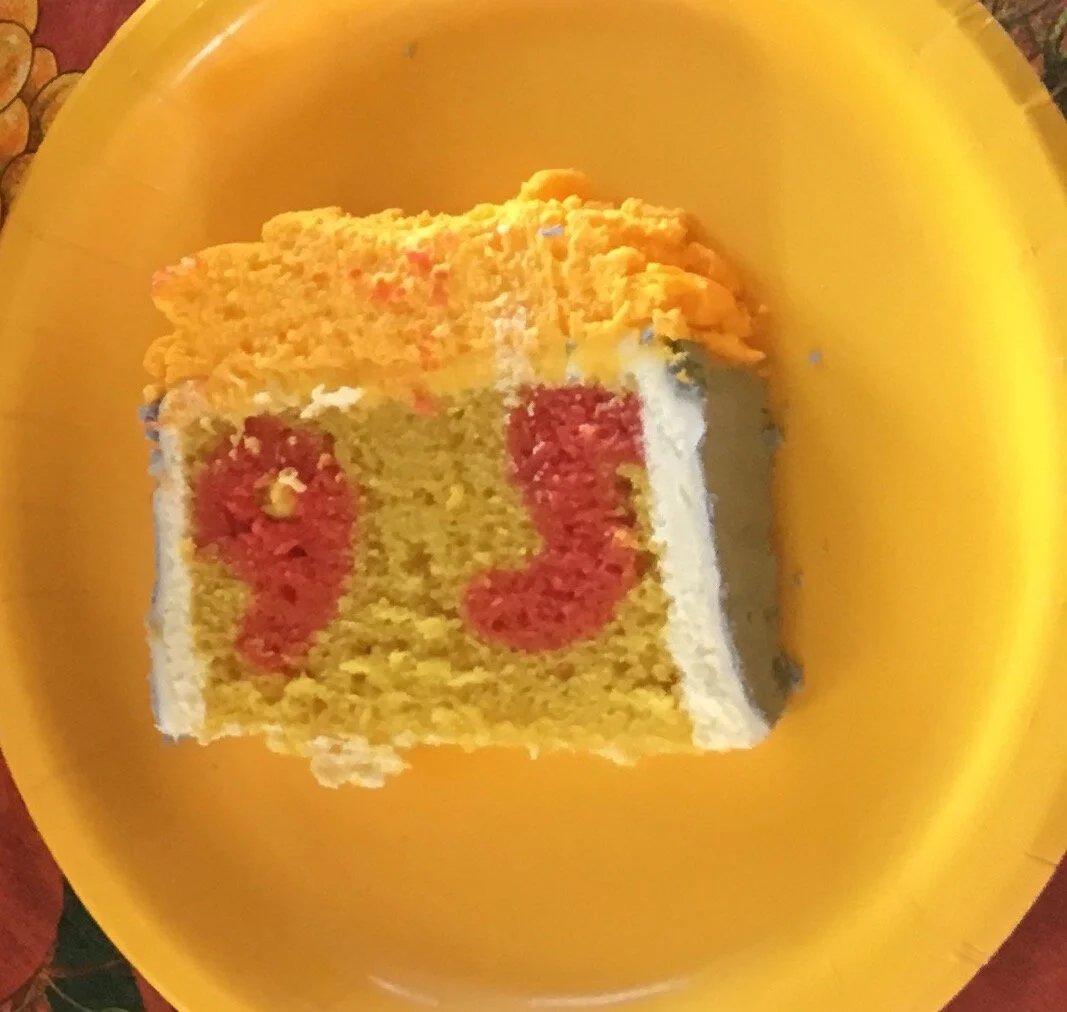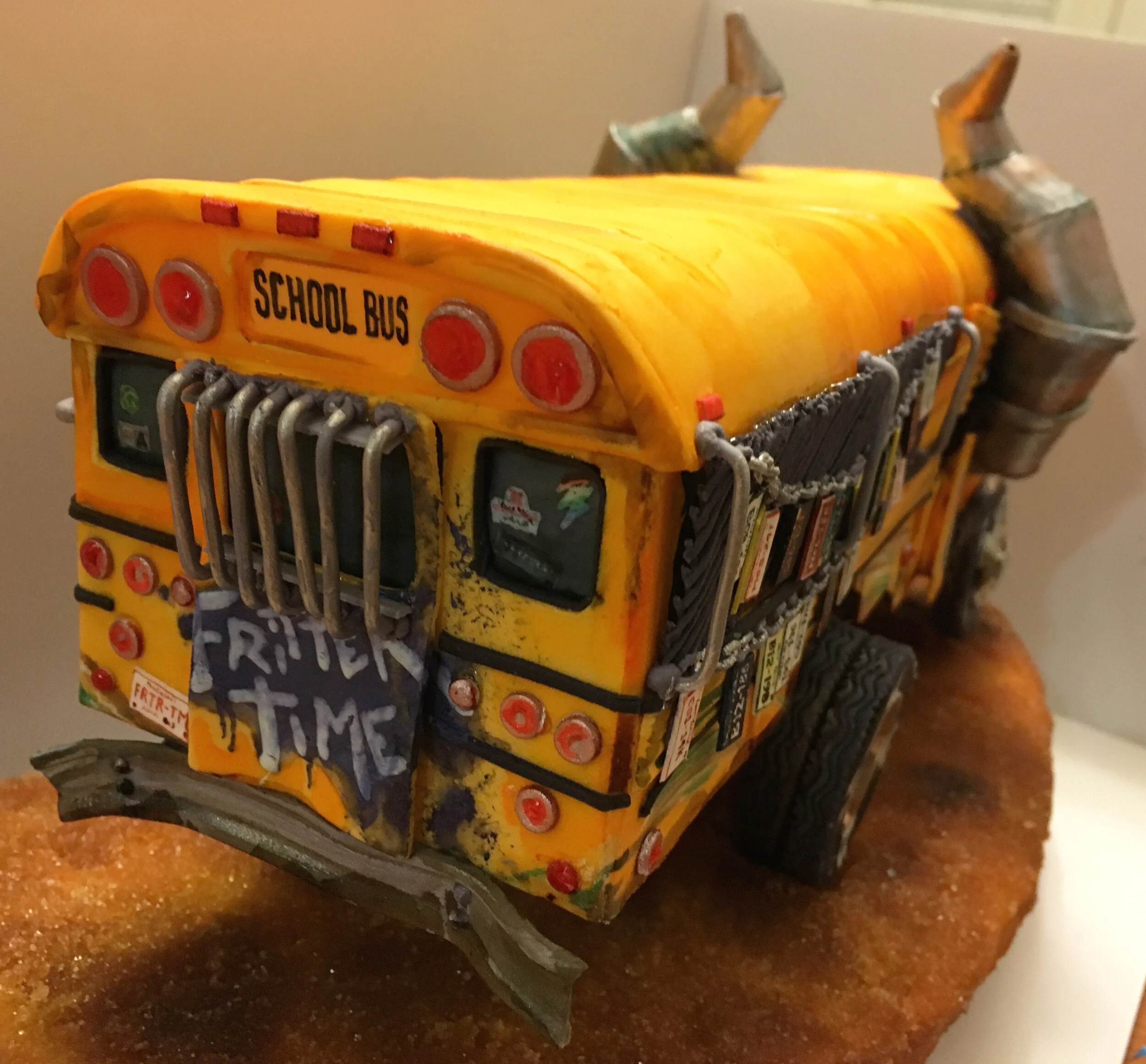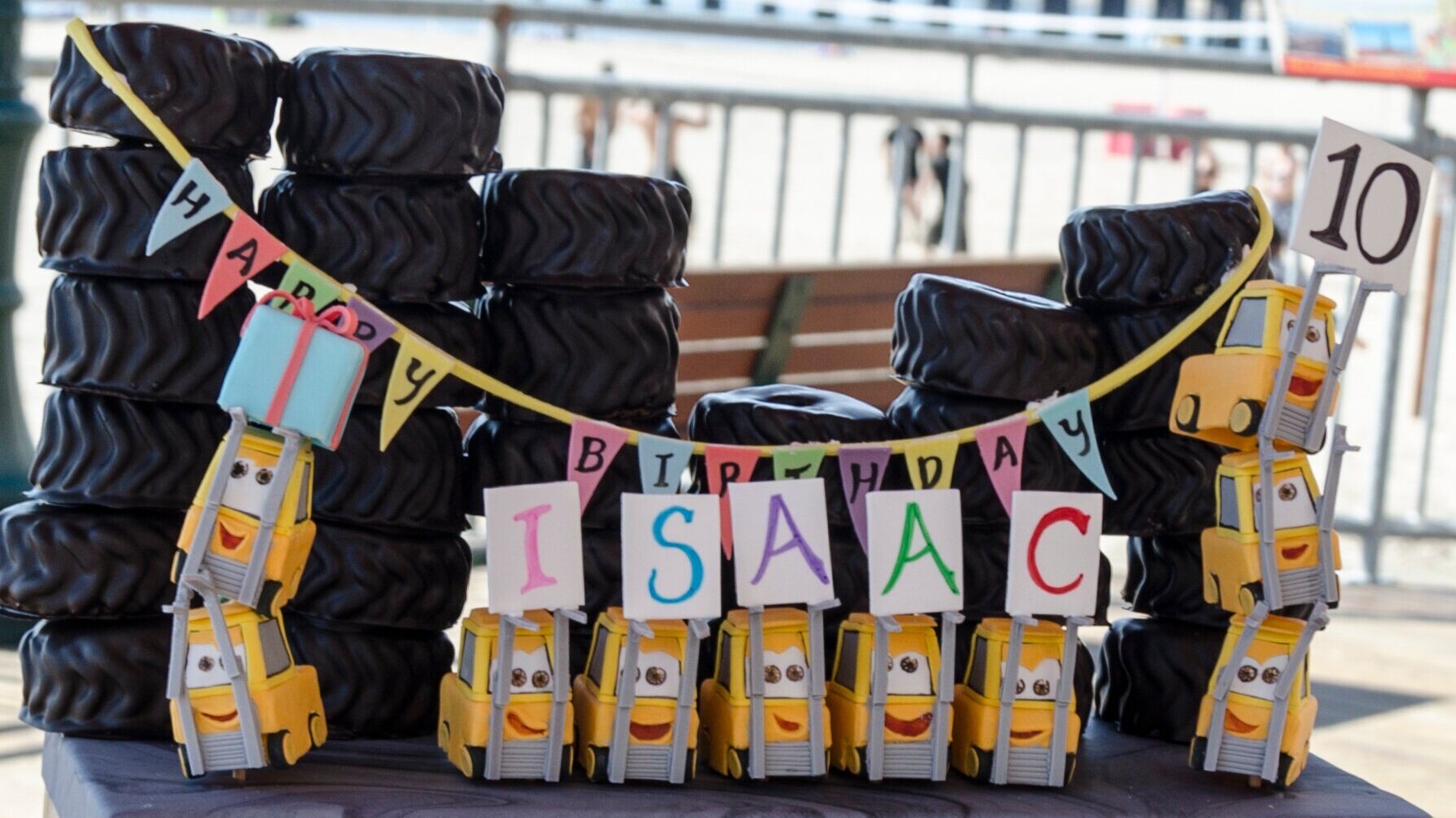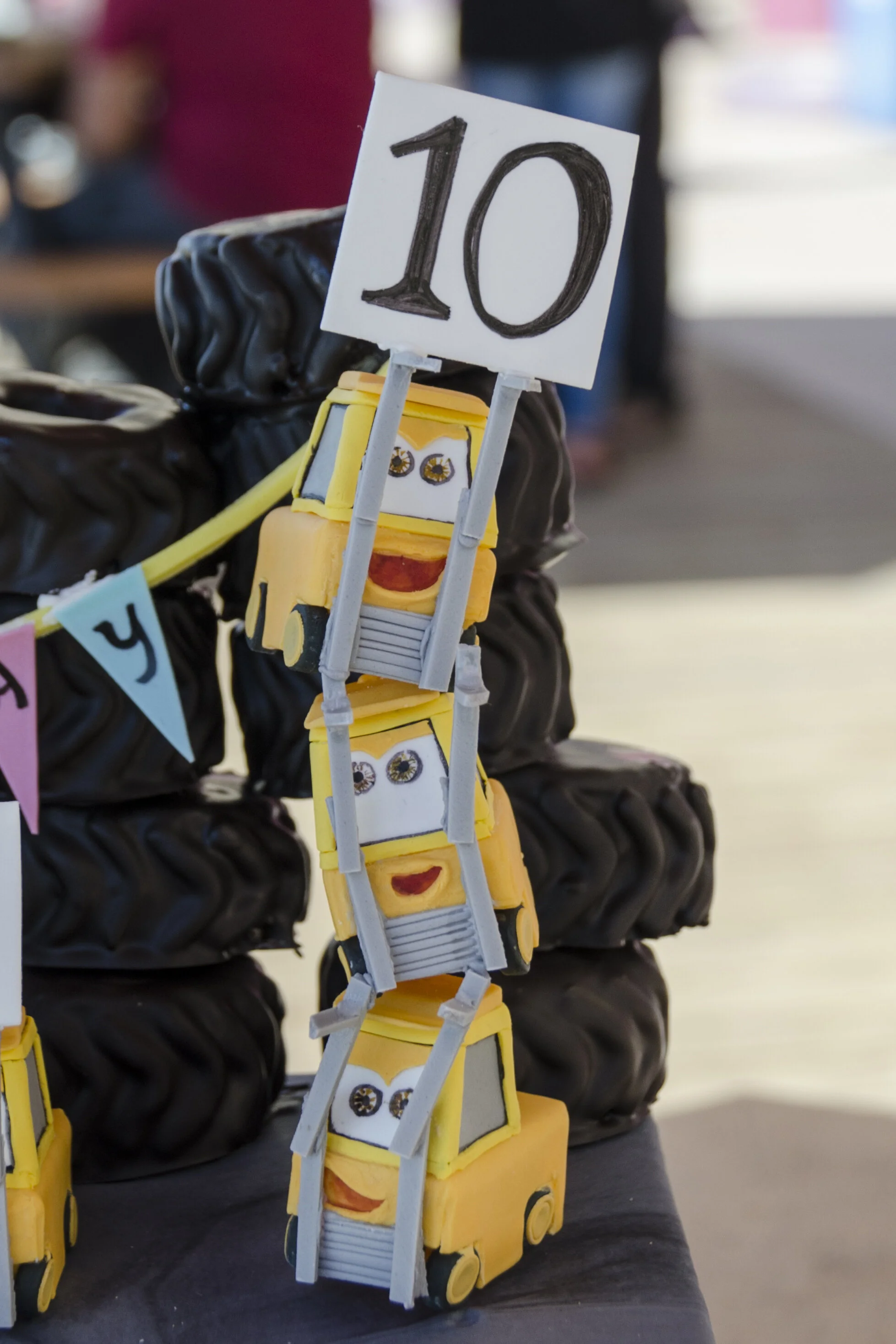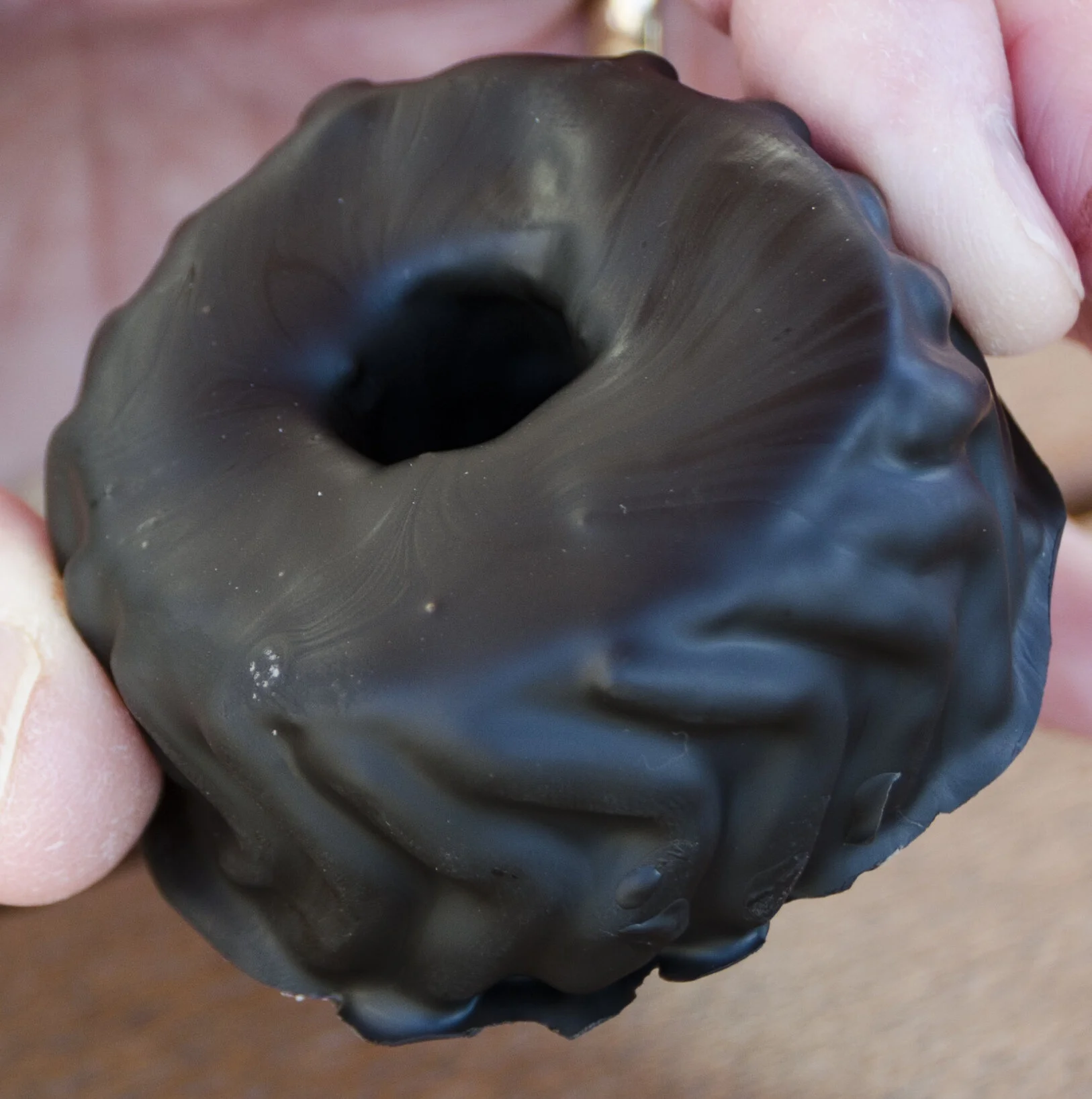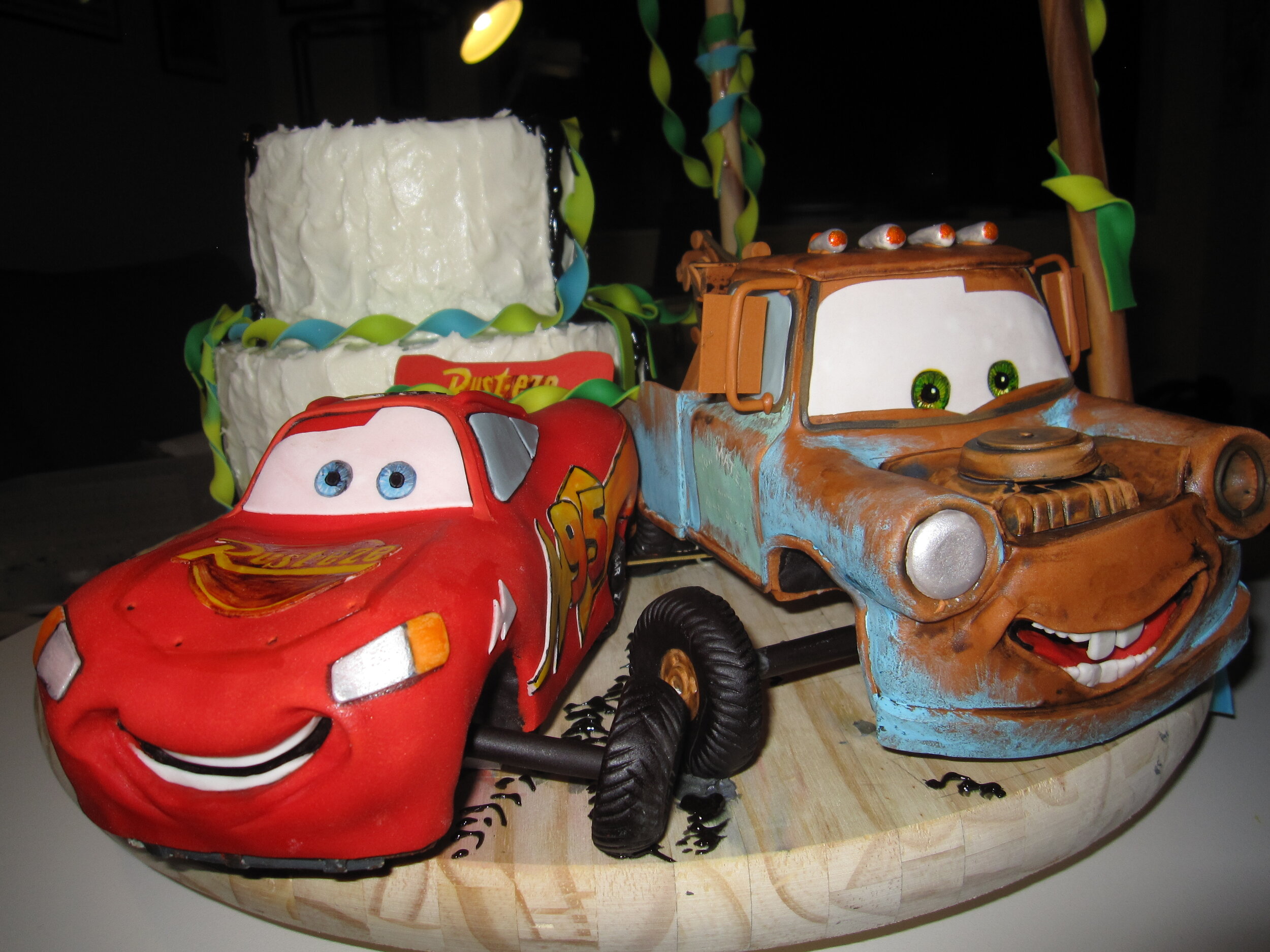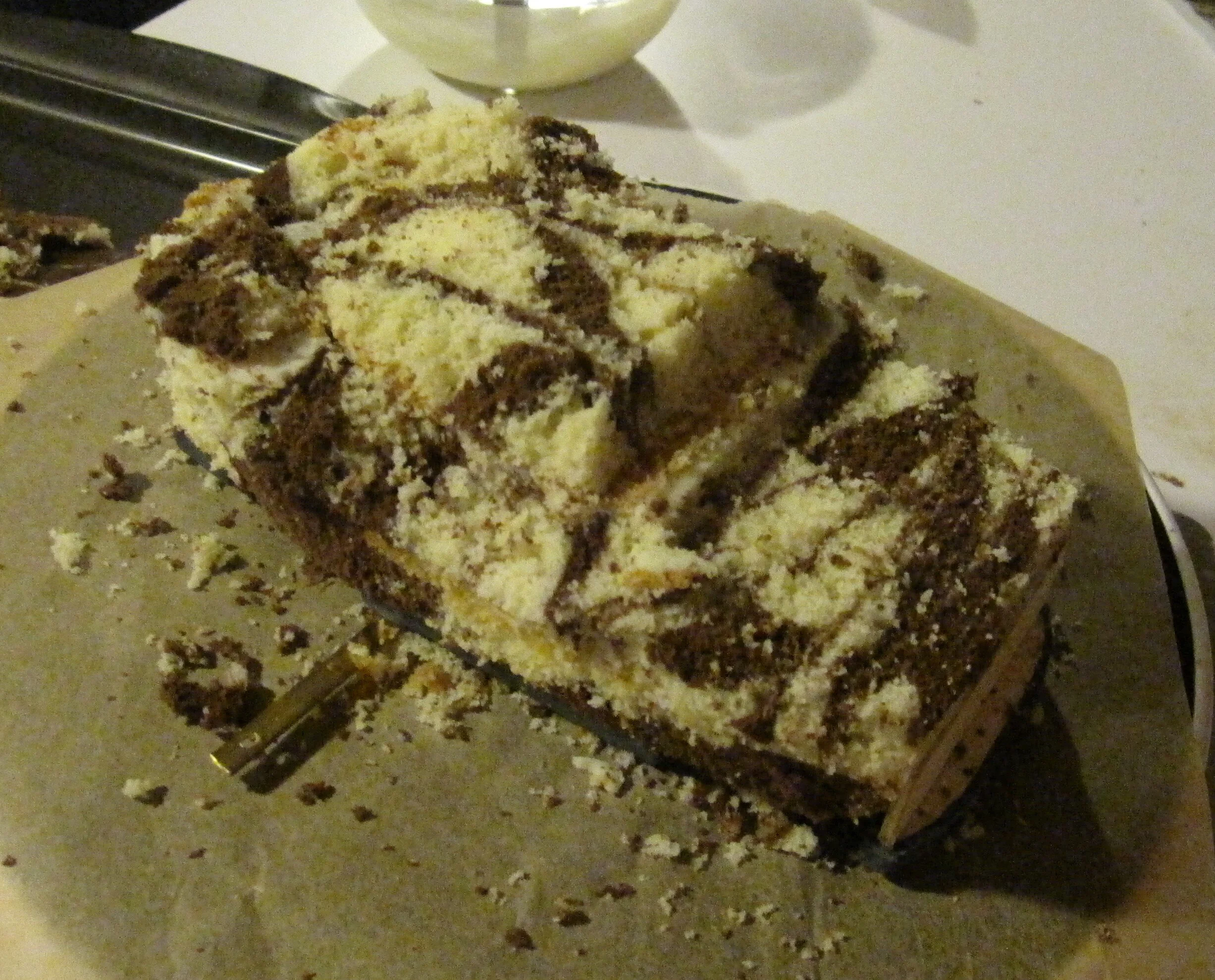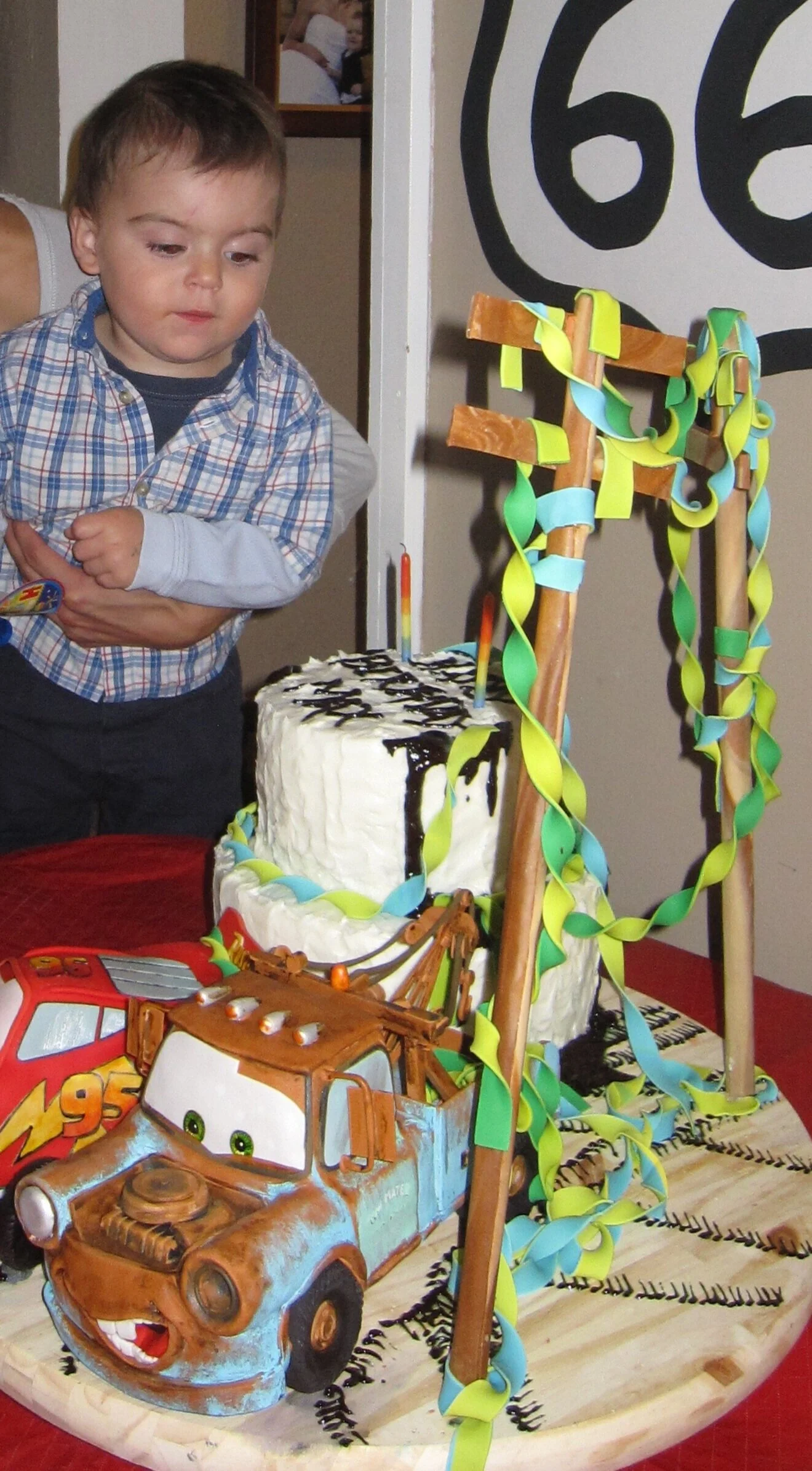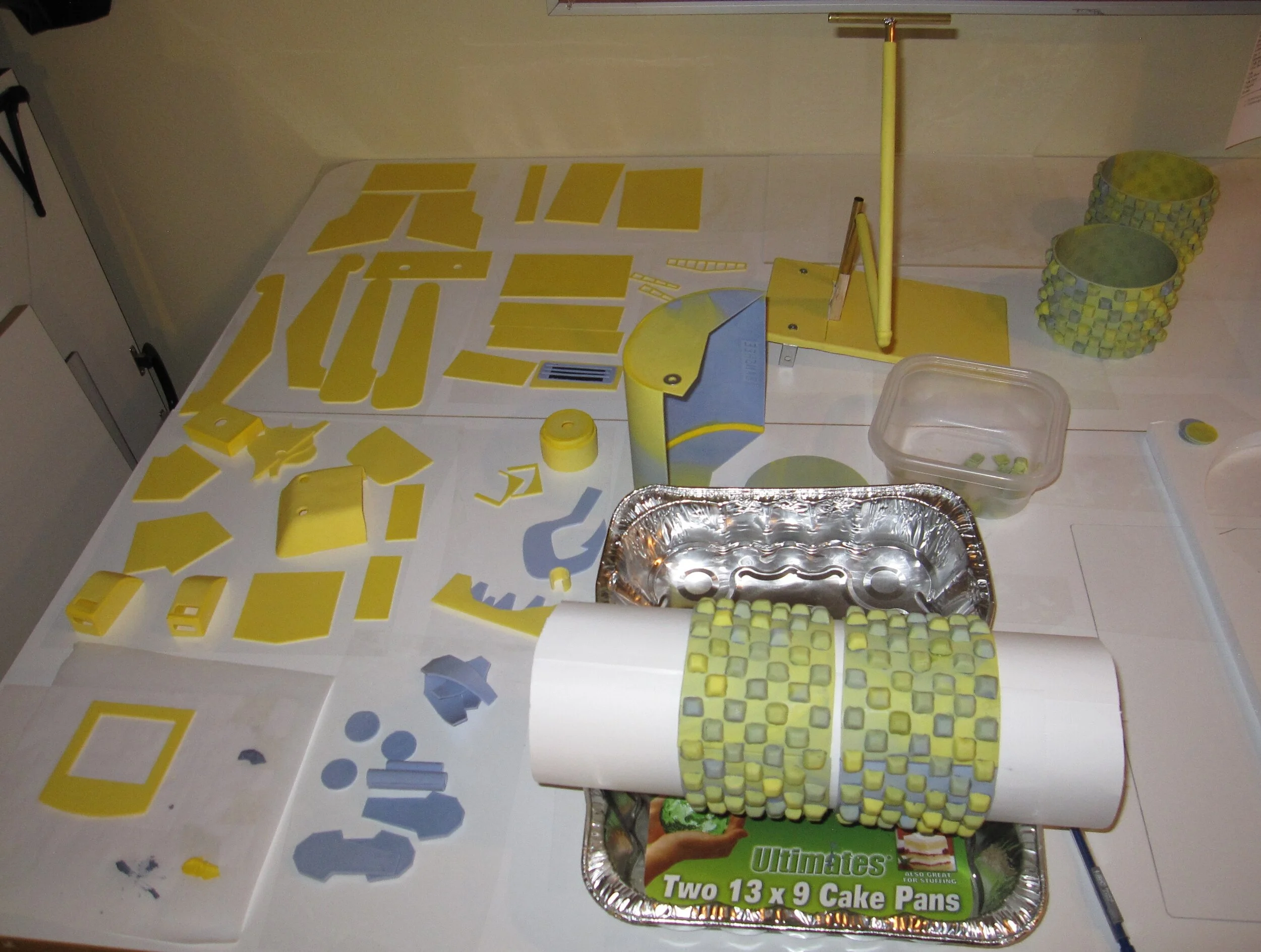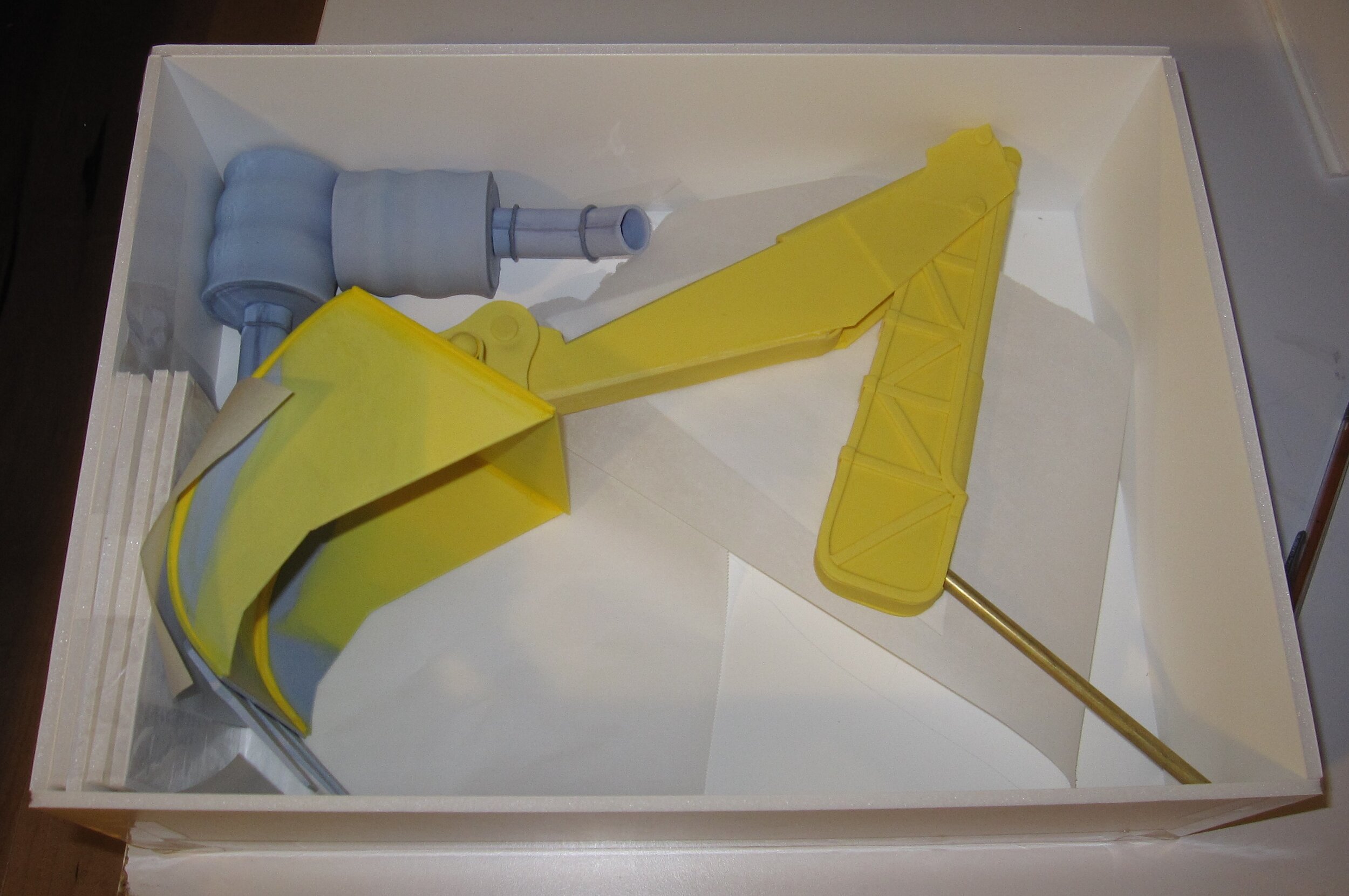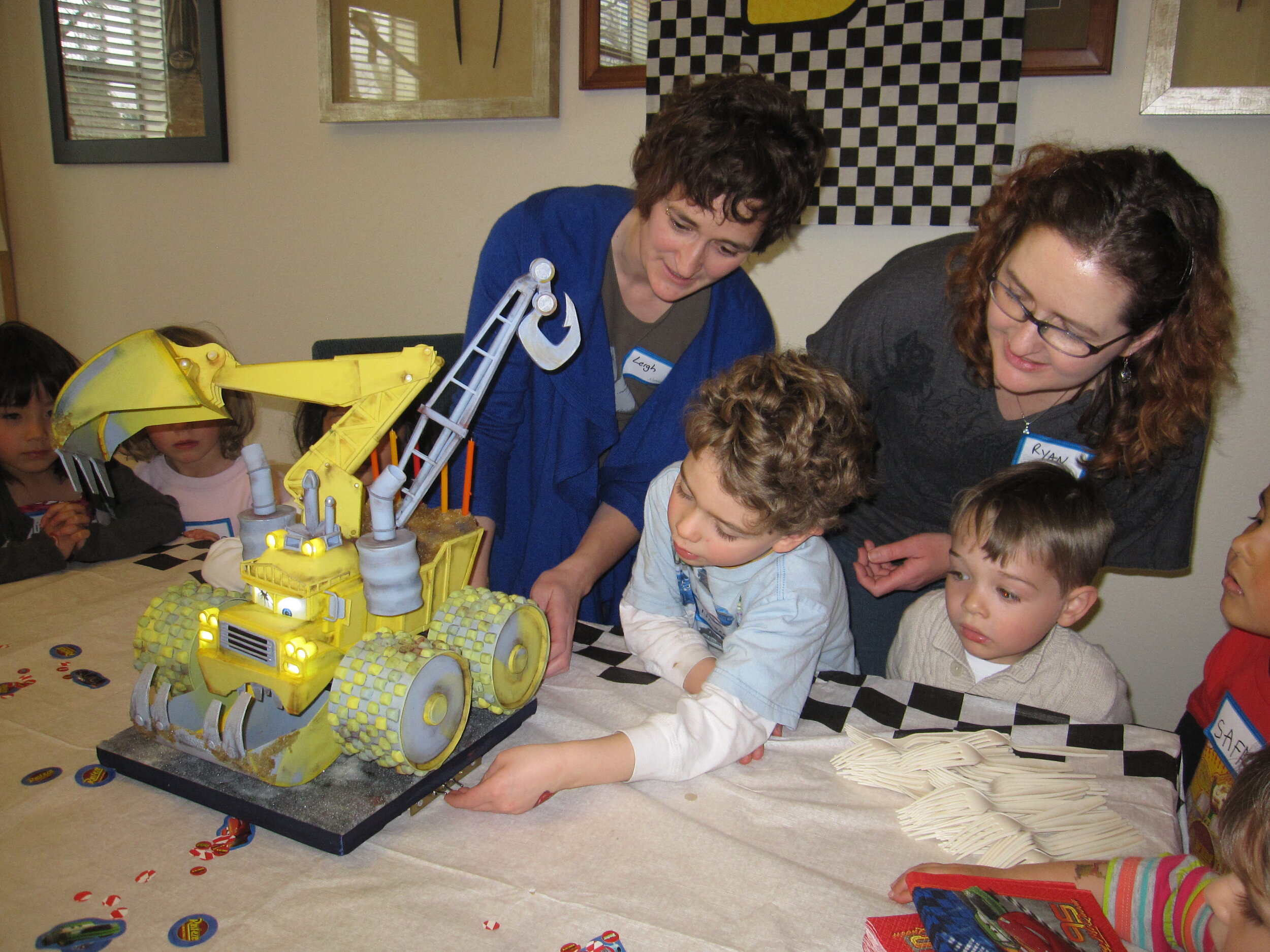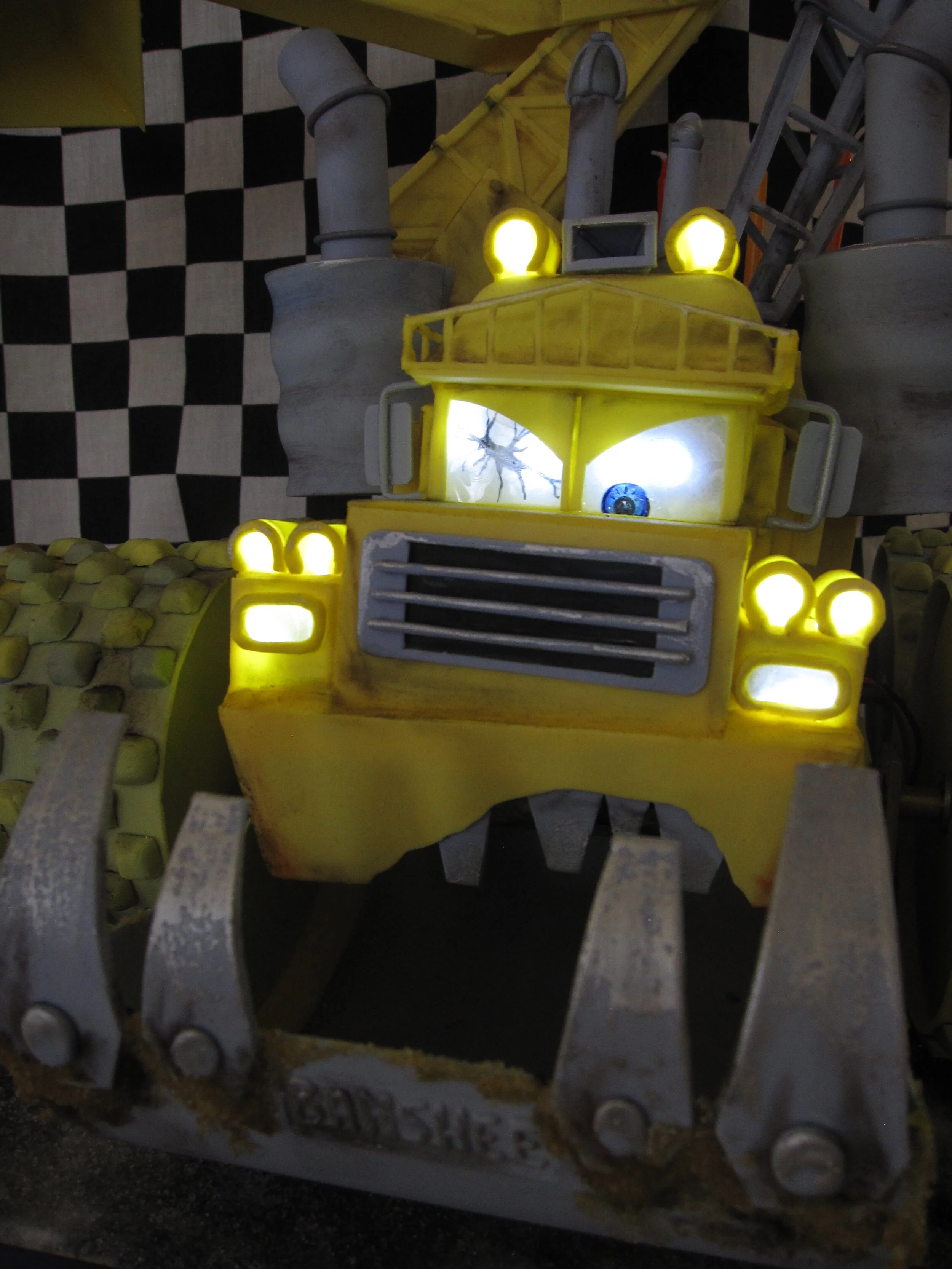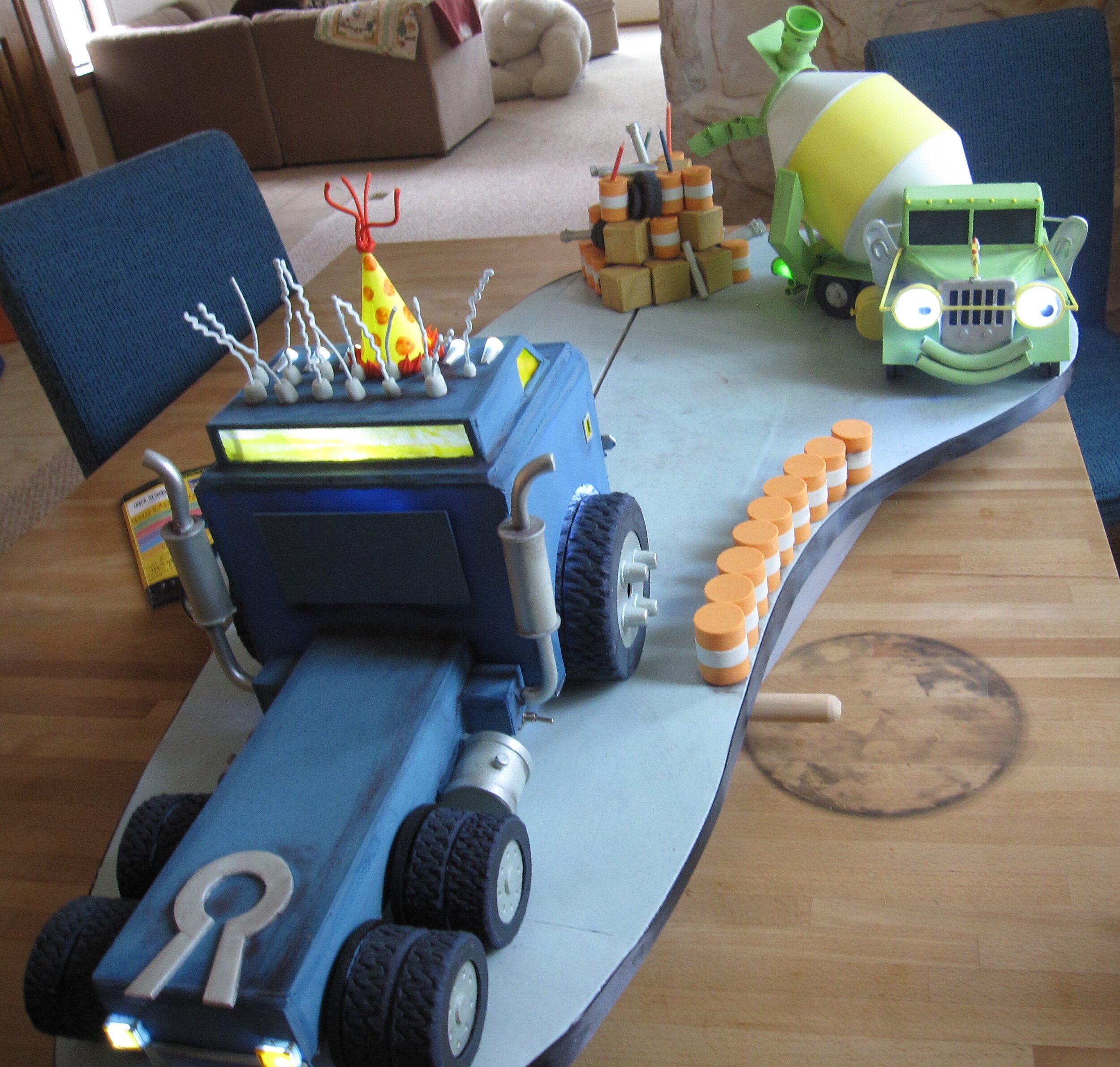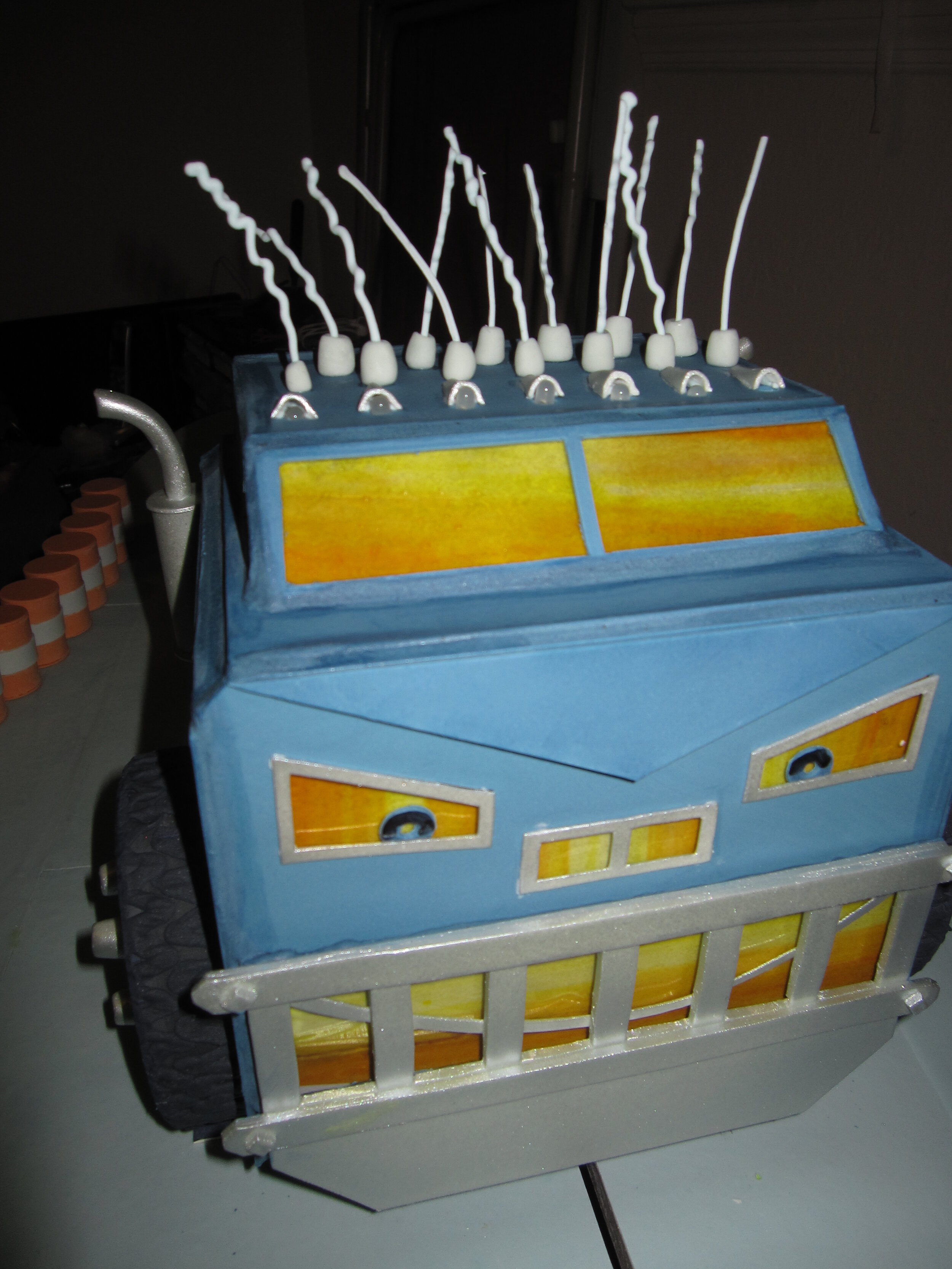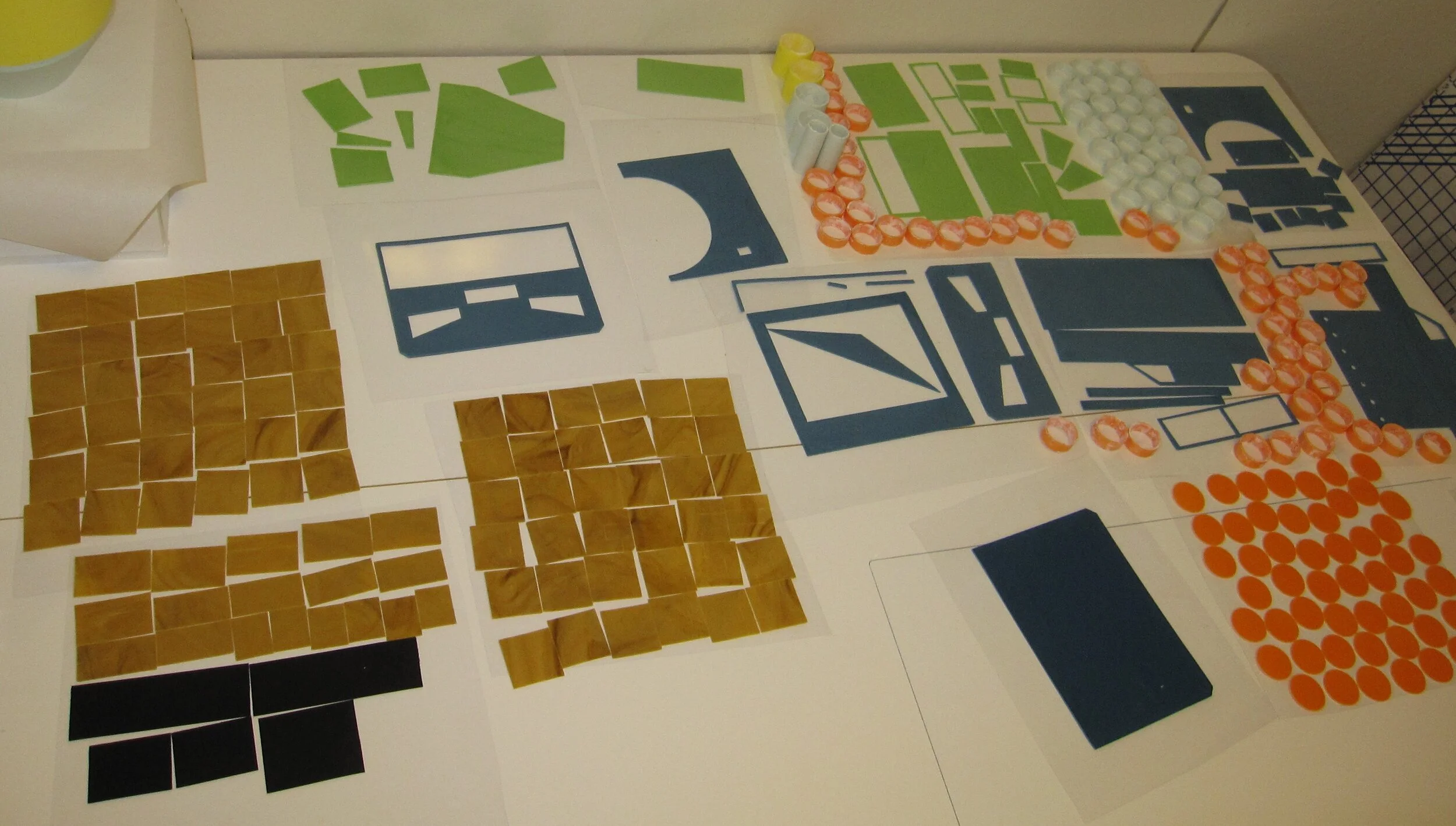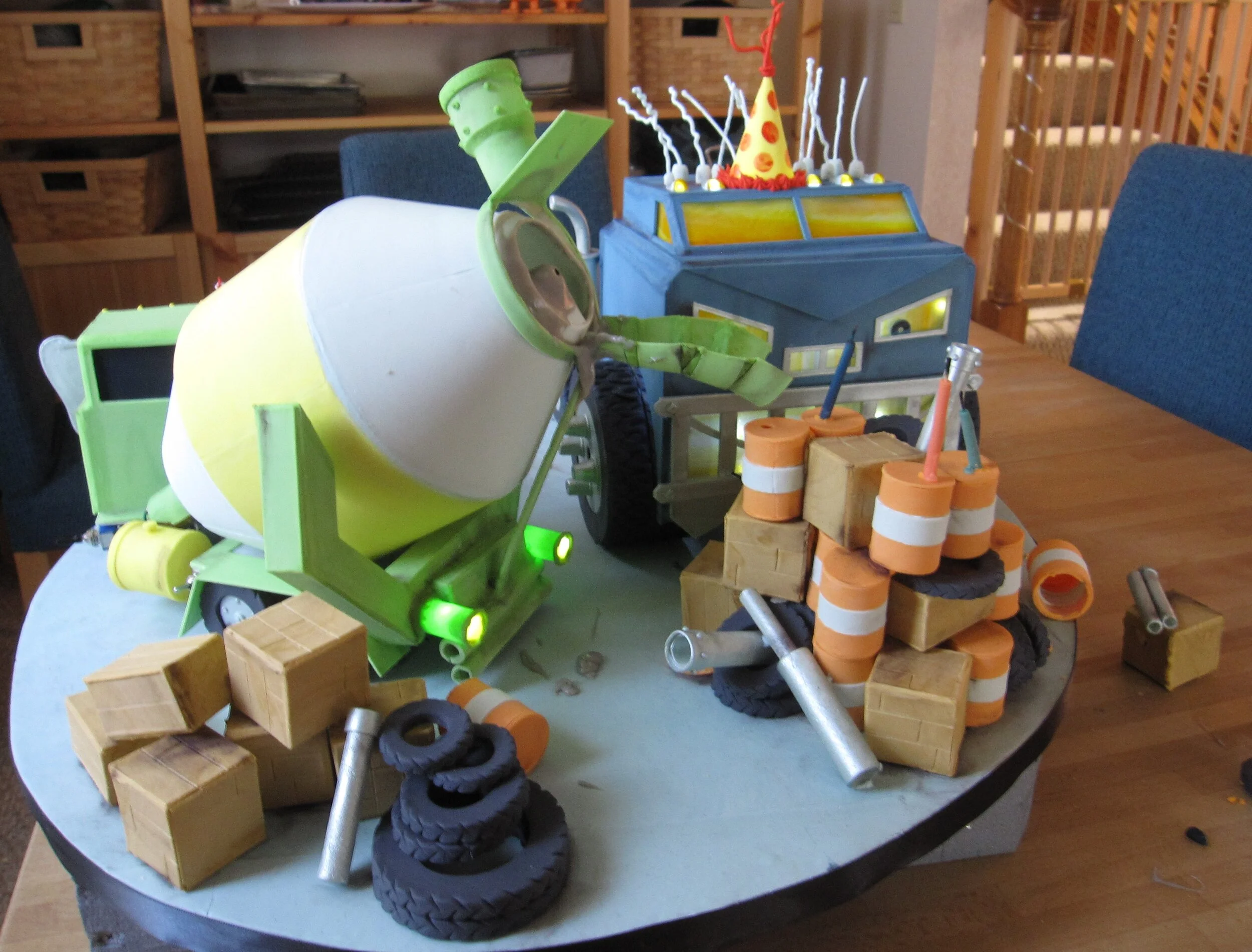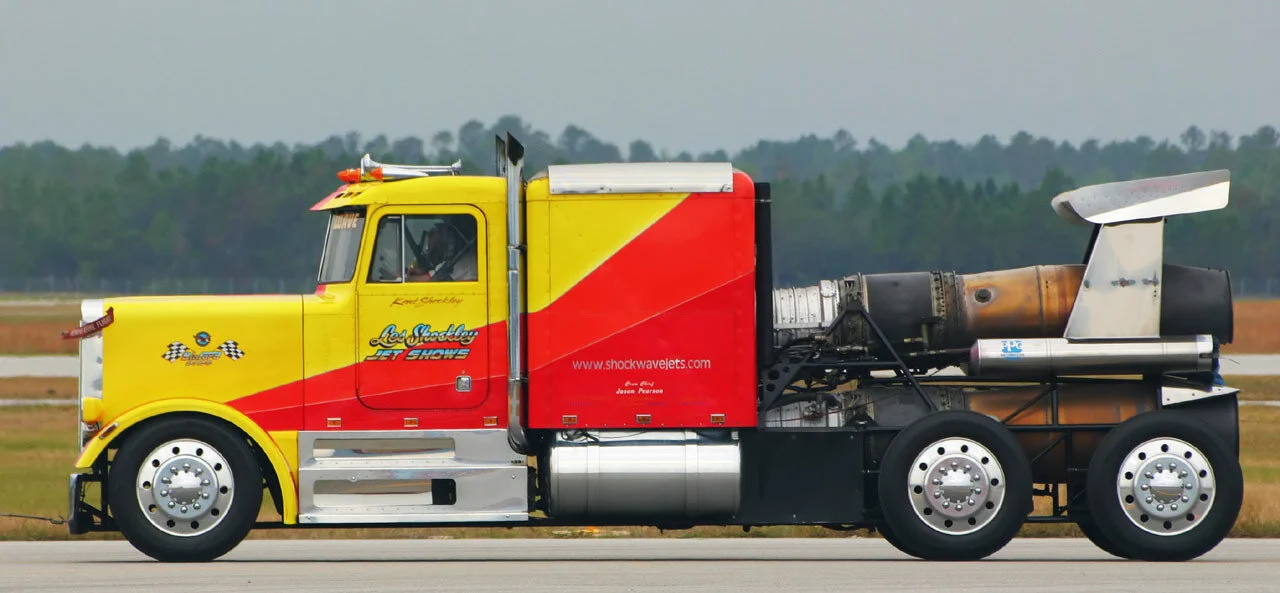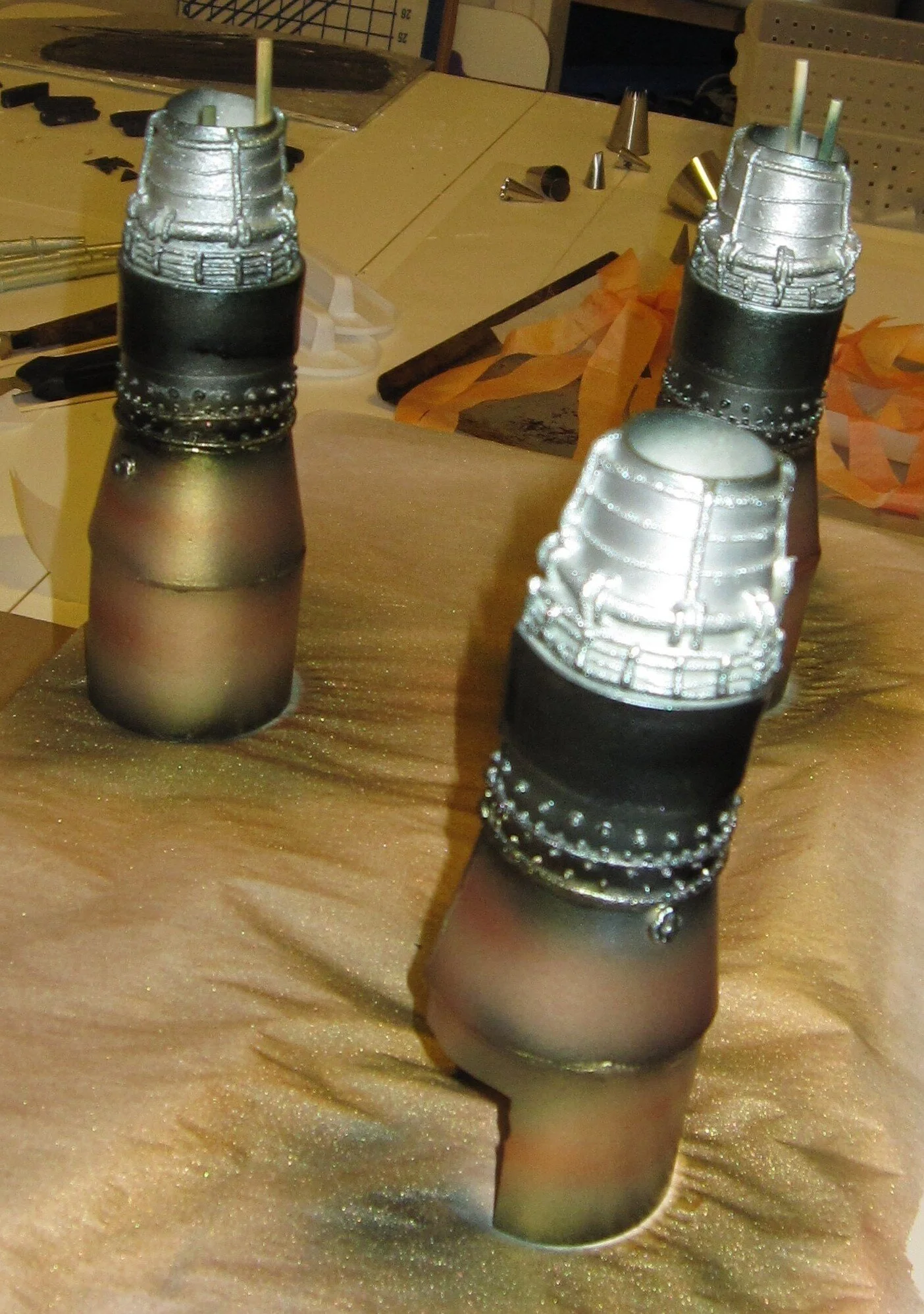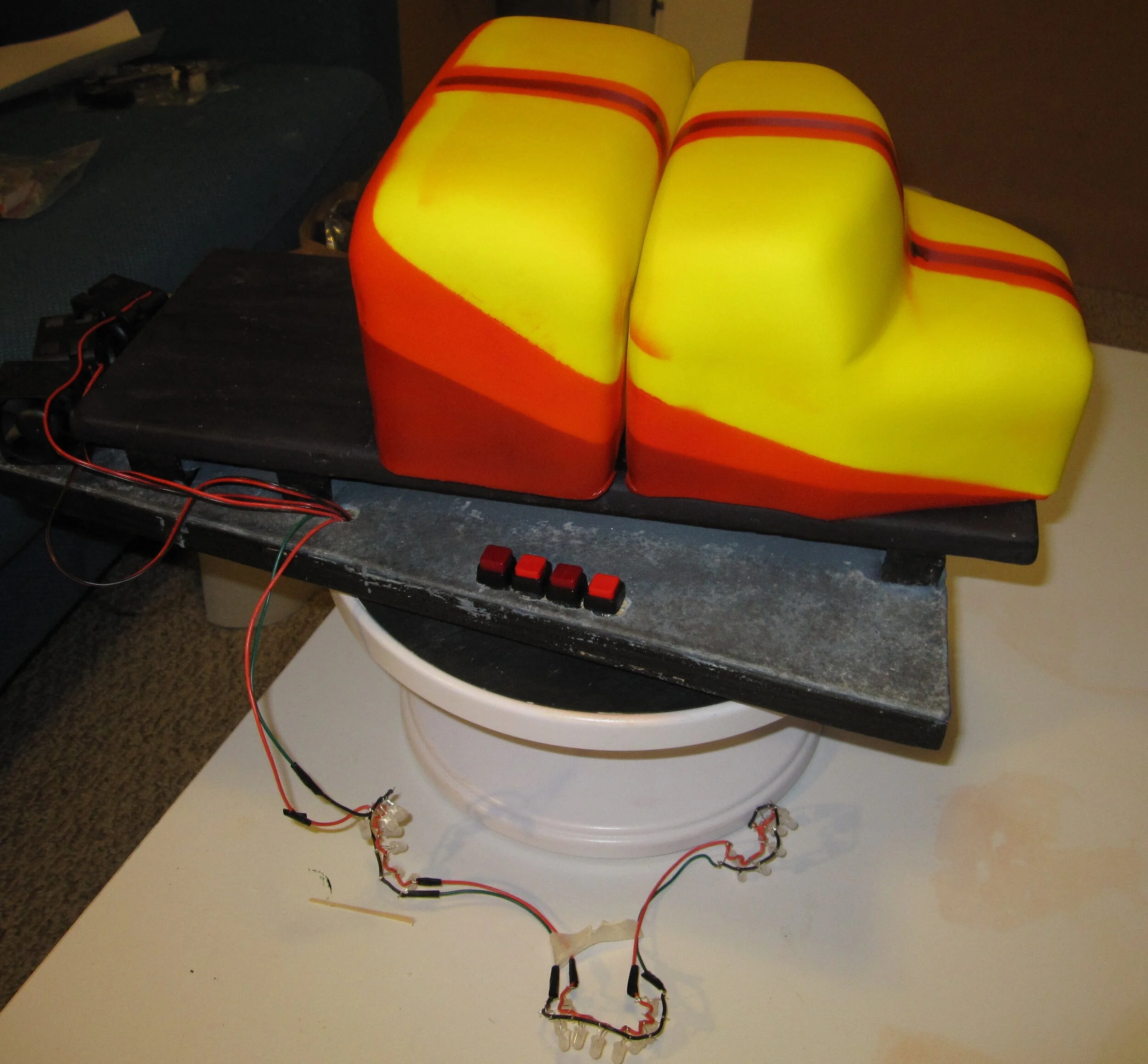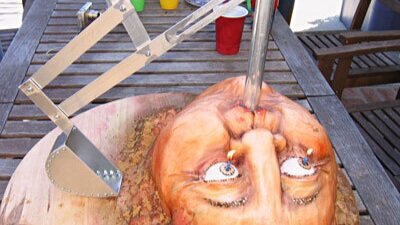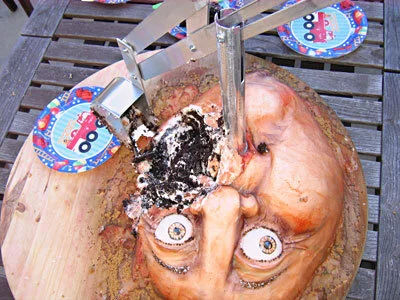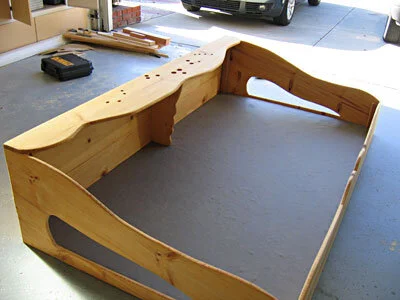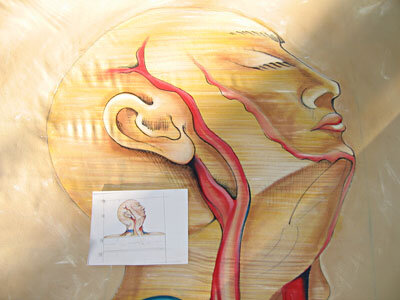Miss Fritter Cake
Look – it’s another Cars-based cake! And one of my best, if I do say so myself.
Look – it’s another Cars-based cake! And one of my best, if I do say so myself. If you’re not an avid follower of the Cars franchise, you might not be familiar with Miss Fritter, so if you need to get up to speed, here’s a video clip.
I’m really happy with how well this one turned out. All the detail is gum paste and royal icing. The hand painting was particularly fun to do.
I also put Lighting McQueen’s number 95 in the middle of the cake because the birthday boy loves numbers.
The nice thing about this cake was that I could just buy the die-cast toy version of Miss Fritter and measure and scale it up. Then I gave the toy to the birthday boy for his present, so it all worked out perfectly.
Here is the cake Miss Fritter next to the toy version I modeled it after and the slightly smaller toy version that the birthday boy already had.
Cars Pit Crew Cake
My little friend Isaac really likes the pit crews from Cars. Fortunately, if there is one thing I’m good at, it’s making anthropomorphic vehicles out of gum paste.
My little friend Isaac really likes the pit crews from Cars. Fortunately, if there is one thing I’m good at, it’s making anthropomorphic vehicles out of gum paste. Over the years, I’ve had a lot of experience.
Because I also like to build automata, I decided to make the pit crew dance.
I really wanted to make it voice activated, with a headset like the pit crew boss. I have successfully made a voice activated automaton before, but for some reason I couldn’t get this one to work so I had to settle for a switch. In the end, the switch was probably better because it was easier for Isaac to use than the voice activation would have been and he really enjoyed turning it on and off while carefully examining the mechanism.
The actual cake is the tires behind the pit crew. They’re a basic sponge cake with a raspberry or blackberry jam filling, with modeling chocolate treads, dipped in dark chocolate.
They were kind of like really fancy Donettes. Which is to say they were fabulous. If I do say so myself.
Mater and Lightning McQueen Cake
For my little friend Max’s second birthday cake, the only guideline that his parents gave me was that the party was Cars themed. So I asked my five-year-old niece for her expert advice on designing a Cars cake. She suggested that I make Mater and Lighting bumping tires.
For my little friend Max’s second birthday cake, the only guideline that his parents gave me was that the party was Cars themed. So I asked my five-year-old niece for her expert advice on designing a Cars cake. She suggested that I make Mater and Lighting bumping tires. What she meant by this was the Cars equivalent of the fist-bump. So the idea that I came up with was a scene wherein Lightning and Mater had just made a cake for Max and decorated it with oil (because that would be delicious to a car). Of course, Mater and Lightning probably haven’t had much experience with making cakes and decorating for parties, so they’ve made a bit of a mess of things, with oil spills and torn streamers. My plan was to have Lightning hanging from birthday streamers wrapped around telephone poles, as if he’d gotten himself tangled while hanging them. This was, of course, meant to be reminiscent of the scene in Cars where Lightning gets tangled in the telephone wires. In the end, this didn’t work out, but I still think the cake overall was a success (and that, next time, I could make the hanging effect actually work).
As with many of my cakes, I made a lot of gum paste pieces in advance, especially for Mater’s bed and tow hook. And, of course, I made fondant tires, which are coming to be quite a specialty of mine. I was especially pleased with Lightning’s tires, once I painted “Lightyear” on them.
I made the telephone poles out of aluminum rod covered with fondant and I made a wooden base for Lightning with brass strips bolted to it, with which I planned to hang Lightning from the telephone poles. This meant that I had to make Lightning’s entire undercarriage, since it would all be visible. I’m not sure whether Lightning’s undercarriage is ever visible in the movie, but I found a Lightning toy that had a fairly detailed undercarriage for me to copy.
With the advance work done, it was time to make the cake. I tried a new marble cake recipe because Max’s mother told me that she likes marble cake. I think it was a tasty recipe, but, oddly, it was a little more challenging than a monochromatic cake to carve. The two colors made the shape of the cake a little harder to perceive as I was working on it.
The little birthday cake was pretty easy, even though I actually don’t do very many simple stacked cakes because they don’t generally interest me. I did a simple buttercream icing on it, and textured it a bit with a spatula. I was striving for that fine line between making the cake look like Lightning and Mater didn’t have much experience making cakes and making the cake look like I didn’t have much experience making cakes. I think I walked the line relatively successfully.
Carving Mater and Lightning went well, again using toys as helpful models. After a quick crumb coat, I was ready to cover them with fondant. Then the challenge was to get all the details on, since both Lightning and Mater have very specific paint jobs. (For those Cars aficionados out there, I went with the original Cars Mater and Lightning, as opposed to the Cars 2 Mater and Lightning, having ascertained that Max hadn’t yet seen Car 2 yet.)
Mater, of course, is so rusty that you start with the brown and then add the patches of blue and green paint on top. I assembled his bed and tow hook with royal icing, which took a bit of time, but it wound up sturdier than I was afraid it might be, which is good since I had to take the cake on a two hour drive to get to the party. I applied white gum paste for the eyes / windshield and blue-grey gum paste for the side windows and then added some extra brown gum paste trim.
To paint the blue and green, I used white food coloring mixed with paste colors. The nice thing about this was that when I then went in with more white to write the text on Mater’s doors, it created a little dark shadow around the letters, where the green paint pulled very slightly away from the brown fondant underneath. This helped highlight the text really nicely. Then I went in with some darker brown to make the rusty parts more interesting before adding the final details like the lights on his head and his one headlight. The most important touches were, of course, his big white gum paste buckteeth, which, looking at them now, I think I made a little too small.
For Lightning, I made templates for all of the decals, and then cut them out of white gum paste and applied them.
I think I did a decent job painting in all the colors, though I wasn’t entirely happy with the Rust-eze sign on his nose, since the brushstrokes were still fairly evident. This is probably the sort of project where the ability to print edible images would really come in handy.
At this point, I made my attempt to hang Lightning. At first, this seemed to go fairly well. The poles were strong enough to hold him up and he seemed fairly stable. Unfortunately, after hanging there for a little while, he began to separate from his base and fall forwards. Fortunately, I noticed this and was able to catch Lightning before he did an actual header down from his perch. At this point, I decided it would be a lot smarter of me to take him down and put him on the ground – although I do maintain that, given another chance, I could have made this work.
With all three cakes – Mater, Lightning, and the birthday cake – in place on the base, it was time for final touches. The fist-bumping tires read well, I thought. I used piping gel colored black to write “Happy Birthday Max” on top of the cake, as well as to glob big oil drips all over the cake. I also added oil tracks crisscrossing the board, as if Lightning and Mater had tracked it around while setting up for the party.
The very last touch was the addition of the streamers. To give them the look of two colors of streamer wound together, I rolled out two very thin pieces of gum paste and them stuck them one on top of the other and rolled them once to stick them together before cutting them to width.
I am sad that I didn’t manage to get Lightning to hang from the telephone poles, because I think that would have been super cool. But Max (and everyone else at the party) seemed to really like the cake. Like all children (at least in my experience), Max for some reason especially enjoyed the fondant tires.
Banshee Cake
My niece Alex’s specifications for her fifth birthday cake: “I want a Banshee cake. And one switch will make the lights turn on and one switch will make the wheels turn and one switch will make the mouth open and close.”
My niece Alex’s specifications for her fifth birthday cake:
“I want a Banshee cake. And one switch will make the lights turn on and one switch will make the wheels turn and one switch will make the mouth open and close.”
Given her previous four birthday cakes, this is a reasonable request, though as you’ll read later in this account, I only managed to deliver on one of the switch operations. Of course, when I made her other birthday cakes, I was living in the same house with Alex. But now, while Alex still lives in California, I am in grad school in Madison, Wisconsin. Fortunately, my spring break aligns fairly well with Alex’s birthday, so I was able to be there for her party, but this meant that I had to make the cake in Wisconsin and then bring it with me to California on the airplane. One thing this forced me to do was to scale the cake such that it would fit in the overhead bin of an airplane, so Banshee was the smallest cake I’ve made in quite a while.
Banshee, of course, is a big work machine that appears at the end of Mater and the Ghostlight, which is an extra short on the DVD for the movie Cars. In fact, Banshee is not even in the short itself; he pops onto the screen only after the closing credits. He appears for all of twenty seconds and you only see him from one angle, which means that I had no idea, from watching the short, what the back half of Banshee looks like. Fortunately there is also a toy version of Banshee, so I bought one, planning to use it as a model for the cake and then give it to Alex for her birthday. However, since I failed to inform my sister and her husband that I had this toy for Alex, they bought her one as well. I gave mine to my little friend Isaac (age 4), who is also a huge Cars fan, so it actually worked out well for everyone.
My first step was to create the electronics. By this point, I’m pretty adept at putting LEDs in my cakes, so the lights were easy. I reused the LEDs that I originally bought for the Tardis Cake. To make the wheels spin, I used a motor that I last used to power Big Rig on Alex’s fourth birthday cake, transferring power to the axles via rubber band drives. I still think it would have worked if my rubber bands had been slightly shorter. Rather than just make the mouth open and close I decided that the whole cake should rise and fall as well, so that Banshee looked like he was breathing, as he does in the movie. So I made an eccentric cam, hooked up to a motor that I had from powering Melvin the cement mixer’s drum, also on Alex’s fourth birthday cake. So as the cam rotated, it was meant to raise and lower the front end of Banshee’s body, which was anchored at the axle for his rear wheels, while simultaneously pushing his jaw up and down. If my motor had been strong enough to actually do this with the weight of the cake on it, it would have been really cool.
Before I made anything in edible materials, I made a full scale mockup of the entire cake in Bristol board. Then I cut it apart to use as a pattern to make the entire exterior of the cake out of gum paste. One nice thing about Banshee is that he only requires two colors of gum paste – construction vehicle yellow and old, dirty metal grey. This helped the gum paste cutting stage to go by fairly quickly. The most tedious part was making the approximately four hundred and twenty little truncated pyramids for the treads of the tires.
Once all the gum paste was dry, I assembled substructures as much as possible with royal icing. Because I was going to be transporting this cake across the country, I used more non-edible supports than I might have normally.
The tow hook and the scoop, for instance, were assembled around brass rods. Incidentally, although I’m breezing over all this in a paragraph, in reality I spent about a month on this stage of the project.
Two days before my flight to California I baked the actual cake. Because I wanted to be sure of a very stable cake for transport I used a chocolate ganache filling, rather than a buttercream. I made three separate little cakes – one for the bottom of the cab, one for the top of the cab, and one for the dumper bed in back. I covered them in fondant because you don’t want gum paste directly in contact with the cake because icing softens the gum paste.
Cake assembly went well. Only a few gum paste pieces were inexplicably the wrong size, but I was able to shave them down to size with a minimum of trouble.
Much more problematic than assembling the cake was packing the cake for travel. This was the first time I had ever tried to move a cake except by car so I was nervous. I had to use basically every inch of my two carry on allotment. For my main carry on I made a foam core box that was about 9”x14”x15” to carry the cake. I also needed to use my extra briefcase carry on allotment to bring Banshee’s scoop arm and tow hook, as well as all the components that made him more than 8 ½” tall. Terrified that my pieces would break en route and I wouldn’t have a cake to give to Alex, I spent at least six hours making boxes, carefully packing components, padding, etc. It was time well spent.
The trip was probably the most stressful flight I have ever endured, with the possible exception of the first solo plane trip I ever took when I was sixteen and flew from Michigan to California to visit my sister in her first year at Stanford. Initially, I had imagined that I would relax once I successfully got the boxed cake through security. This turned out not to be the case.
Security screening went pretty well, although I was so nervous that my hands were shaking. If I hadn’t been allowed to take the cake on the plane, it would have been game over. Fortunately, I was flying out of the Madison, Wisconsin airport, which is by far the most laid back airport I’ve even been to. The only other airport I’ve been to that even comes close is in Paro, Bhutan, an airport so remote and exclusive that only two airplanes are allowed to land there. I got to the airport about three hours early to be sure to have plenty of time to get through security. Obviously, they needed me to open the boxes, but the security personnel were very respectful of the cake’s fragility and complimentary of its appearance. After they swabbed my hands, the cake boxes, and the switches I was cleared through security and safely on my way.
At this point I realized that I couldn’t relax because I was traveling by myself and didn’t want to take my cake into the bathroom with me to pee. Fortunately, I ran into a friend in the airport bar whose flight to Albuquerque had been delayed, so she was able to watch my cake while I ran to the ladies’ room.
Getting onto the plane was also terrifying because the first leg of my itinerary was Madison to Chicago, which is a short commuter flight on a very small plane. When the gate attendant in charge of gate checking carry ons came around the gate area, he told me that I would probably not to able to fit both of my carry ons onto the plane, which to me would have been a complete disaster. However, after a half hour of sitting in the gate area in terror, I was able to stow the cake under the seat in front of me and my other item in the overhead bin. I cannot tell you how relieved I was that this worked out.
In Chicago, I had to carry the cake from one end of the airport to the other to get to my next gate, but at least it fit more easily onto this plane than the last one. A flight attendant even saw it in the overhead bin and offered to put an ice pack on the box to keep the cake cool.
I arrived in California late Friday night and the party was scheduled for Sunday afternoon. On Friday, all I could do was open the box to verify that the cake hadn’t completely collapsed before I fell asleep. I spent Saturday playing with the kids, so I didn’t get to unpack the cake completely until Saturday evening after the kids went to bed.
Amazingly, the cake came through the journey completely unscathed. Literally only one piece broke, and it was a piece that I had extras of, so it didn’t even matter. Even in my best case scenario, I had expected to have to effect at least minor repairs. I was completely flabbergasted by how well the cake traveled.
I spent Saturday night completing the assembly of the cake, installing the hook and the scoop, and adding finishing touches to the paint job. I also used some pressed sugar colored with brown food coloring for dirt on the teeth and in the dumper bed, where I also installed the five candles.
The party was fantastic. Our friend Sara brought awesome Cars decorations and balloons. My sister had invited Alex’s entire preschool class plus several other friends, so there were about 20 children. I’m not sure how they even all fit in the house.
Sadly, Banshee’s wheels didn’t spin (I think the rubber bands weren’t tight enough) and he didn’t go up and down (I think the cake was too heavy for the motor), but otherwise he was very well received. The most important thing is that Alex was happy. Happy and full of sugar.
Zoom! Boom! Bully Cake
For my niece’s fourth birthday, I made a cake based on Zoom! Boom! Bully from John Scieszka’s Trucktown.
Those of you who don’t happen to be immersed in the magical world of three- to five-year-old children are probably not familiar with John Scieszka’s Trucktown. So I recommend that you follow the link so you know what the heck I’m talking about.
My personal favorite book in the Trucktown series is actually Smash! Crash!, but since the occasion for this cake was my niece Alex’s fourth birthday, Zoom! Boom! Bully was a more appropriate reference. The basic plot is that various denizens of Trucktown stack up crate, barrels, and tires in the middle of the street, but are periodically disrupted by the aptly named Big Rig smashing into them (Zoom! Boom!). The other trucks then exclaim about what a bully Big Rig is. The big surprise in the end is that it’s Big Rig’s birthday and the other trucks are making him a birthday cake out of the crates, barrels, and tires, which Melvin the cement mixer then pours cement “icing” on. Big Rig, very touched by the other trucks’ thoughtful gesture, picks up the “cake”, takes it back to his garage, and proceeds to gleefully smash it while wearing a festive yellow party hat.
I decided to recreate the penultimate moment of the book in cake form, consisting of three components:
1) The “cake” made of tires, crate, and barrels.
2) Melvin the cement mixer, with a rotating drum in the process of dumping cement onto the “cake”.
3) Big Rig, who would smash face first into the “cake”.
When I explained this concept to Alex she was very enthusiastic, if a bit disappointed that Jack Truck and Dump Truck Dan wouldn’t be on the cake.
The first thing I had to do was figure out how the heck I was going to make any of this happen. The easiest way to describe the process is probably to take each piece separately, though of course these projects were running concurrently.
Melvin the Cement Mixer
I learned a lot about cement mixer drums. The first thing I learned was that it’s very difficult to find detailed schematics of them on the internet. Eventually I resorted to studying Alex’s toy cement mixer. As far as I’ve been able to determine from these authoritative sources, cement mixer drum interiors consist of a series of semicircles, angled and staggered such that when the drum turns one way the cement is propelled towards the bottom of the drum and when it turns the other way the cement is pushed up and out the chute.
I made a whole series of Bristol board mockups with various sizes and densities of semicircles, trying them out using little pieces of paper as a cement substitute. None of them even came close to working. So I branched out and tried some other variations on the internal structure. Finally I settled on a helical arrangement of triangular wedges spiraling up towards the top of the drum. This seemed to at least sort of work.
With the basic structure settled, it was time to remake the drum in gum paste. The exterior of the drum was made in three pieces around Bristol board forms. Once these and the myriad little triangular wedges were dry, I assembled them with royal icing around a brass tube for the center support. Assembly was a lengthy process, as I had to wait for the icing on each wedge to dry before attaching the next one.
With the drum assembled around the central tube, I superglued the tube to the shaft of a reversible gear head motor (once I had figured out how to wire up the motor to make it reversible.) Mounting the drum and motor assembly to the base was a real challenge. I had made a pretty simple base for Melvin out of a cut-up aluminum baking sheet, covered with gum paste, and elevated off the wooden base for the entire cake with L-brackets, so the body of the truck would ultimately appear to be resting on its tires. In Zoom! Boom! Bully, Melvin’s drum appears to be supported from beneath in the middle by two angled beams, but there doesn’t seem to be a support for the back of the drum. This, of course, also raises the question of what Melvin’s rear chute is attached to.
My plan was to build the side support beams out of gum paste around pieces of brass, bolted to the aluminum base. Because, unlike the people illustrating the book, I physically needed something on the back to support both the drum and the chute, I decided on a brass ring mounted on a strip of brass and wrapped in gum paste, also bolted to the aluminum base.
The first time that I put this all together with the motor and the gum paste drum, I set it up so that the lowest point on the drum was resting on the aluminum base, on which I had put some UHMW tape to keep friction to a minimum. I thought that this would help to support the weight of the drum and keep stress off the motor. This turned out to be a very bad plan, as I had failed to account for the fact that, in spite of my best efforts, I had failed to center the drum perfectly on the central brass tube. This meant that when I turned the motor on, as soon as the part of the drum that was slightly further from the axis of rotation got around to the bottom, it jammed against the base. I turned the motor off as soon as I realized what has happened, but not soon enough. As the central brass tube was still trying to rotate while the drum itself was jammed against the base, the royal icing connected the gum paste drum pieces to the brass tube cracked. D’oh!
A few tense hours and one major royal icing repair later, the drum was reattached to the tube. In order to prevent this from happening again, I made a new, slightly higher brass ring to support the back of the drum and raised the motor, and therefore the front of the drum, about a half an inch as well. That way, the drum never touched the actual aluminum base and was supported only by the motor on one end and the brass ring on the other end. It worked!
Once the drum turning mechanism was in place, finishing the back of the truck was relatively simple. I covered the motor in green gum paste and assembled the gum paste pieces of the side support beams. Having previously made tires out of black fondant and hubcaps out of gum paste, sprayed silver, it was easy to attach these, as well as the gum paste wheel wells.
I had also wired up some white LEDs to use for Melvin’s taillights and headlights, so I put the LEDs for the taillights in place and then ran the wires underneath the aluminum base so they’d be in place for the headlights once I got his head assembled. The taillights themselves I made out of gum paste cylinders, capped with rice paper (to diffuse the light) and yellow gelatin (to give the light the correct hue.) In the past, when I’ve needed sheet gelatin (see the Tardis Cake and the Flying Saucer Cake) I’ve used the pre-made kind, but since that has a strange diamond pattern on it, this time I tried making my own flat sheet gelatin, using these instructions that I found on the internet. After a few abortive efforts, it worked pretty well.
Assembling the chute took a little time, because it was made of six separate pieces, which had to be attached one at a time, with sufficient time for the connective royal icing to dry before attaching the next one.
With the back of Melvin thus complete, I had to make his head, the only part of Melvin that contained actual cake. This went very smoothly. Having made all the exterior gum paste pieces in advance, it was simply a matter of carving the cake into the appropriate shape, covering it with fondant, and then setting it in place on the aluminum base. Then I could assemble the gum paste exterior with royal icing, including more tires and wheel wells, the ears / side view mirrors, and eyeglasses / headlights (which were assembled around the rest of the strand of LEDs.) To fill gaps and hide seams, I used royal icing, smoothed with a damp paintbrush.
For cement, I made some white chocolate ganache, tinted grey with black powdered food coloring. Mind you, at this point I still didn’t know whether the drum was properly configured to actually push the cement out and down the tube, and I wouldn’t find out until the party.
Big Rig
My biggest challenge of this cake was figuring out how to make Big Rig roll. It was also pretty high pressure because, let’s face it, if Big Rig didn’t smash into the “cake” the whole project would pretty much be a blatant failure. With almost all of my cakes, I accept that there is a fairly high probability that it might not work as I intend. My philosophy is that if you always know that what you’re doing will work, you’re not trying hard enough. Which is fine when the only people who are going to be disappointed with a failure are me, or my adult friends, or the guests at my friends’ wedding. But I really didn’t want to disappoint Alex. So in this particular case, I really couldn’t let failure be an option.
Keeping Big Rig on the right trajectory was the easy part. I attached two L-brackets to the bottom of Big Rig’s aluminum base, a material which I had selected to keep his weight as low as possible. Then I cut a track in the plywood base for the entire cake, running from the far end where Big Rig would start, leading to the end of the base where the “cake” would sit. That way, the L-brackets, slotted into the plywood track, which I had lined with UHMW tape to reduce friction, would keep Big Rig on target to the “cake.” All I had to do was get him to move.
My first attempt at a drive mechanism was to connect a hobby motor directly to the shaft of one of the front wheels (made out of plywood, to be covered later with gum paste tires), so it would basically be a one-wheel drive car. This failed for at least two reasons. First, because the two front wheels weren’t connected to each other via a complete axle, both had a tendency to bind up in their bushings, so that moving even the light aluminum base without any cake on it took all the motor’s power. Second, because only one wheel was driving the truck, it had a tendency to try to pull the truck off course so that the L-bracket bound up in the track.
So I scrapped that and tried something else. This time, I connected the two front wheels with a brass and threaded rod axle. My plan was to transfer the power from the motor to the axle with a heavy-duty rubber band under tension. This plan failed even before I connected it to the wheels, as the minute that I started experimenting with putting tension on a rubber band around the shaft of any of the hobby motors I had in hand it became clear that none of my motors had nearly enough torque to get the job done.
I went online and located a promising-looking high-torque motor. While I was waiting for that to arrive, I started playing around with the possibility of a motor-less drive mechanism. My first thought was a tension spring. Unfortunately, a few major problems with this idea soon became clear. First, the length difference between the relaxed spring and the spring under tension wasn’t nearly enough. I couldn’t pull the truck all the way back to the end of the track, and even with the spring fully relaxed I was afraid that the truck wouldn’t even reach the “cake” to smash it. Second, I was very scared that, if I had to keep Big Rig under that kind of tension for any length of time there was a significant risk of premature smashing, which would be a real tragedy. Third, I really wanted Big Rig’s tires to spin on their own, so I could start the wheels spinning, and then release the truck for the final smash. There’s a great illustration in Zoom! Boom! Bully where Big Rig’s tires are spinning into a whirl of smoke just as Jack shouts, “Stop!” and the other trucks reveal that the “cake” is for Big Rig’s birthday. I really wanted to recreate this moment in cake before the smash, and that required motor power directly to Big Rig’s wheels.
I managed to solve the first of these problems by substituting a jumbo-sized rubber band for the spring. The rubber band had a much higher stretch-to-length ratio than the spring, and the flexibility of the rubber band meant that even after its tension was exhausted, it at least wouldn’t arrest the momentum of the truck. The rubber band also seemed to have sufficient power to move the truck fairly quickly, even with the projected added weight of the cake and gum paste. But the rubber band still left my other two concerns unaddressed. It still required the truck to be under tension for a longer period of time than I was comfortable with, unless I could come up with a release mechanism that I could set after the cake was completed and moved into place. And in order to achieve the effect I wanted with the tires spinning prior to release, I really needed tires that were legitimately motor-powered.
Fortunately, when my high-torque motor arrived, early signs were encouraging. Unlike the motors I was trying before, it was clearly powerful enough to withstand the tension on the rubber band. So I mounted the motor to the cake base and ran the rubber band to connect the motor shaft to the axle. Initially, I was delighted with the result. With no weight on the aluminum base, the truck drove great. However, as soon as I put some weight on it, to mimic the weight of the cake and gum paste I was planning to put onto Big Rig, it stopped working altogether, as the added weight was sufficient to counteract the tension on the rubber band and cause it just to slip uselessly around the axle. I tried to mitigate this problem by putting something sticky on the axle, but this just made the rubber band stick to itself and get wound up around the axle.
Next, I tried using gears to transfer the power from the motor to the axle, which required a complete redo of the front bushings to leave space between the axle and the aluminum base for the gear. Like the rubber band drive, this worked great until I put any weight on the base. Unlike with the rubber band, the truck did at least move with additional weight on it. It just moved very slowly. I did have hopes, though, that if I kept the cake as light as I possibly could, it might work.
To give it an extra boost of power, I decided to combine this partially successful motor solution with my partially successful rubber band solution. I designed a release mechanism consisting of a piece of U-shaped channel that ran across the track, underneath the base, attached to a dowel handle leading out the side of the base. That way, with the rubber band connected to one of the L-brackets under the truck base on one end and an eye bolt at the “cake” end of the track at the other end, I could finish decorating Big Rig with the rubber band relaxed, and then pull him back and set the L-bracket into the U-channel. This would hold him in place, and hold the front wheels a fraction of an inch off the base, so I could turn the motor on, let the wheels spin freely for a second, and then pull the dowel to release him. The rubber band would pull Big Rig forward while the wheel simultaneously pushed him forward. I could only hope that would provide enough force to make him powerfully smash into the “cake.”
And thus ends the saga of making Big Rig go, but I still had to actually make Big Rig. Because Big Rig has a kind of maniacally glowing face, as well as taillights and a menacing glow inside his wheel wells, he needed a lot of LEDs. Fortunately, by this point I’ve done so many LED-intensive cakes that I could basically just chop and splice segments together as needed, so the wiring went pretty quickly.
All the gum paste pieces, including tires, hubcaps, fuel tanks, bumpers, walls, trim, and yellow party hat, were made and dried in advance. To get the requisite orange and yellow glow out of Big Rig’s eyes, mouth, etc. I made sheets of gelatin with fades from yellow to orange, backed with rice paper to diffuse the light form the LEDs.
The cake itself was limited to the back of Big Rig and a very small square of cake inside his cab. At the party, someone pointed out that it was like a little cake engine block. I couldn’t put a bigger cake inside his head, because I needed to leave space around it for the LEDs. I kept the fondant layer on the cakes (necessary to prevent the gum paste from touching the buttercream icing, which softens dried gum paste) as thin as possible to keep the weight down. Fortunately, since I was covering the entire thing with pre-made gum paste pieces, the fondant didn’t have to look particularly nice.
With the cakes in place, attaching the gum paste exterior and all the trim pieces was really quite simple. The only problem I had was that when I redid the front axle bushings to accommodate the gears, I had failed to make the corresponding changes to the templates for Big Rig’s cab, so the sides, front, and back of the cab were all about half an inch too short. Fortunately, I had some extra dry blue gum paste pieces that I was able to cut down to patch the gaps. With some liberal royal icing spackle, it turned out just fine. The finishing touches were the royal icing antennae on the top. I have no idea why Big Rig needs so many antennae (which is what I told Alex when she asked me that question) but he has them in the book, so he had them in the cake.
“Cake”
Although the “cake” was the easiest component in that it didn’t have to do anything but sit there and be smashed, it also required more individual gum paste pieces than (I think) Melvin and Big Rig put together. Each barrel was made of five separate gum paste pieces and each crate required six. At the early planning stages of this project, I had envisioned putting tiny individual pieces of cake inside each crate and each barrel. Considering that the crates were only an inch and a half on each side, and the barrels were even smaller, I’m very glad that I came to my senses before I tried to do this. It’s not like there wasn’t already more cake than our guests would possibly eat anyway. Instead, I just put a little square of cake inside the “cake”, surrounded by the hollow crates and barrels and fondant tires. This probably made for a better smash in the long run anyway.
In addition to the crates and barrels, the cake also included a selection of fondant tires and gum paste pipes. Since I had made way more of all these things than were actually required, I used the extras to create bonus piles of stuff around the perimeter of the plywood cake base.
Finishing touches
With everything assembled, I actually went to bed at a relatively reasonable hour the night before the party. The next morning, as I was putting on the finishing touches – mostly adding a little dirt and grime with black powdered food coloring – Alex came in to inspect my work. She walked around it, studying it very carefully and commenting favorably on specific elements, like Big Rig’s tires and Melvin’s articulation. She then pointed out that I needed to put eyes on the chicken hood ornament on Melvin’s nose, which was already on my list of details to finish up before the party.
Alex then noted that I hadn’t made a hitch for the back of Big Rig. I had considered making a hitch for Big Rig, but decided against it because it doesn’t play any role in this scenario and because in some of the images in the source book, he doesn’t appear to have a hitch. Alex listened patiently to this explanation and then countered by pointing out that, in Truckery Rhymes, Big Rig is shown towing a trailer, which he couldn’t do if he didn’t have a hitch. I was forced to bow to her superior logic and quickly made a gum paste hitch. Actually, it even looked better from an aesthetic point of view, as the silver hitch made the solid blue rear section of Big Rig much more interesting. What I especially love about Alex’s argument is that it draws not just upon the specific source book for this project – Zoom Boom Bully – but upon the rest of the Trucktown canon as well. I also enjoy that it is a functional argument. Her point was not merely that Big Rig should have a hitch because he is shown with a hitch in the illustrations, but that Big Rig needs a hitch or he would be unable to fulfill his function as a big rig.
With the hitch completed, I got Alex’s dad to help me move the cake out to the dining room. Then came the stressful moment when I had to pull Big Rig back into his release mechanism. I was terrified that I was either going to lose my grip and send him crashing into the “cake” or crack Big Rig’s head to pieces in the effort of pulling back the rubber band. Fortunately I avoided either catastrophe and got Big Rig primed for release with only the loss of one fuel tank that was easily reattached.
Alex then consulted the source material for one final check on the accuracy of my work. She pointed out that, in the book, the “cake” is shown on a wooden palette, and I had failed to put my cake version of the “cake” onto a palette. I explained that I had noticed that and had considered putting the “cake” on a palette but had decided against it as I was afraid that the palette would arrest Big Rig’s movement so that he wouldn’t smash into the “cake” as effectively. Alex considered this carefully and then decided that perhaps Big Rig had taken the “cake” home on the palette and then removed it from the palette in order to smash it. I agreed that was an excellent explanation.
The party
With only one exception, the cake worked very well. Melvin’s drum turned flawlessly, but sadly, he did not actually pour cement. Either the drum and/or the wedges inside weren’t angle correctly or I had made the ganache too thick. Also, I didn’t really know which way the drum was supposed to be turning to make the cement come out. Cement mixers are complicated. Oh well, at least the drum turned.
Most importantly, Big Rig worked! Zoom! Boom! One of the barrels even flew off the table. Big Rig’s front bumper cracked beautifully so that he wound up with an excellent jagged evil grin.
Alex had a great time eating various gum paste bits (and a little bit of actual cake.) I particularly enjoyed it when she ate one of Melvin’s eyes, revealing the LEDs and leaving Melvin looking like a mangled cyborg.
The next day, as Alex was helping me to disassemble the remains of the cake and salvage the electronic components, she told Melvin (who was by this point essentially just a severed head) that he was her favorite cake ever. I call that a big success. Alex was a very tough audience with an incredible eye for detail. She was tremendously critical, but with such sincerity and such admiration. She has absolute confidence in my ability to execute a perfect cake version of Big Rig, so of course she wants to point out my errors so that I can correct them. It’s such a charming combination of exactitude and blind faith. She’s the perfect manager.
Jet Truck Cake
This cake was for my nephew, Sam’s, first birthday. It’s based on a real truck.
This cake was for my nephew, Sam’s, first birthday. It’s based on a real truck. When I asked Sam’s big sister Alex, who was, at the time, almost four years old, what kind of cake she thought that Sam would like for his birthday, she gave me very detailed specs:
Tractor-trailer – w/o trailer
Racing truck
Racing trucks are yellow.
Jet engines on the back
Flame powered engine
Flames come out of exhaust pipe
Flame powered fuel
Button to turn on flames
Alex will show Sam how flames work
Flames come out of jet engine
Flame powered fuel tank on the side
When I showed my notes to my sister, Alex and Sam’s mom, she immediately knew what truck she was thinking of. Evidently she had seen it in a video on youtube. A few google searches later, I had some great reference photos to work from.
Since the planned birthday party would be attended by numerous small children, I decided that having actual flames shoot out the back of the cake would be a bad idea, even if I could accomplish it in a food-safe way. Instead, I planned to make basically a miniature version of the flames on those plastic Halloween cauldrons where a light and a fan inside the cauldron make some waving fabric look like relatively convincing flames.
Ultimately, it didn’t work out nearly as well as I had hoped, for several reasons:
1) Initially I had hoped that I would be able to substitute something edible for the fabric “flames” but I was unable to come up with any food item that was thin, dry, lightweight, and flexible enough to fit the bill. The closest I came was the skin of a bell pepper, but that was too brittle when dried.
2) I bought white fabric, but then dyed it red and orange with food coloring, which stiffened it a bit more than was optimal so it didn’t move as fluidly as I wanted.
3) Fans small enough to fit inside a 2” diameter gum paste rocket aren’t all that powerful. I bought a couple of different ones to try out. I thought the ones I decided on would work, but once I got them all the way hooked up with the fabric I found that they didn’t have enough punch to move strips of fabric more than a couple inches long.
4) When I stuck the fabric to the gum paste rockets, I did it in such a way that the air only passed over one side of the fabric, not both. Unfortunately, I didn’t realize what a big error this was until it was too late to do anything to fix it.
5) When I installed the fans and rockets on the cake, I didn’t leave enough room at the back of the rocket for air to get sucked into the fan. Again, I realized the error too late to correct.
So the flame effect wound up being mediocre at best, but otherwise I think I captured the essence of the jet truck pretty well.
For the base, I started with a trapezoid of plywood. I guess I though that a trapezoid would give it more of a sense of motion than a rectangle, but I’m not sure it really did much. I used grey run-in royal icing, with white and black food coloring sponged on to make it look like asphalt. On top of that I painted yellow lane markers with thinned royal icing and then yellow food coloring.
To raise the body of the truck up off the ground, I mounted a second, thinner piece of plywood, on top of some sections of 1” aluminum channel, positioned so that that channel would later be hidden behind the tires. I covered this piece of plywood with black fondant.
At this point I did all the wiring for the fans and the LEDs to light up the inside of the rockets. I got some nice big red buttons to turn them on and off because I thought that Alex would enjoy that.
Next, I used gum paste, detailed with royal icing, to make the rockets, the grill, the spoiler, the hubcaps, the wheel wells, the fuel tanks, the bumpers, the reflectors, the license plates, and so on and so on. I used fondant for the tires and a few of the other bulkier trim pieces.
Shiny chrome truck bits gave me a chance to try out my new metallic edible airbrush colors. I was a bit skeptical, but they worked great. I was especially pleased with the job I did on the rockets.
For the cake itself I started with three 10” square cakes, carved into the two separate pieces of the cab, then crumb-coated with buttercream. Once covered with fondant, the corners were more rounded than I wanted, giving the truck a more puffy, cartoon-ish look than I would have liked. I’m reaching the conclusion that the only way to get nice, sharp mechanical corners is to pre-make gum paste pieces like I did for the Tardis cake.
My plan was to cover the front cab section first with blue fondant then with yellow fondant so that I could cut the yellow fondant away from the windows revealing the blue fondant beneath. (This is after I decided that my original plan to actually create an interior for the truck that could be seen through the windows was not feasible in the time I had available.) I have never personally tried this technique before, but I have seen them do it many times on Ace of Cakes, so I figured I ought to be able to do it easily. It probably would have worked just fine, except that I decided to wait to cut out the windows until after I airbrushed the orange and red stripes onto the cake.
Masking parts of the cake off and airbrushing is another technique I’ve seen on Ace of Cakes, but this was my first try at it. It worked relatively well, but next time I’ll be more careful with my masking, since I did have a few spots where the color bled under the paper.
By the time I was finished airbrushing, the top yellow layer of fondant had completely fused to bottom blue layer of fondant, so it was utterly impossible to remove one without removing the other. So I cut all the way through both layers for the windshield, the side windows, and the front grille, all the way down to the crumb-coat, and then stuck a new piece of blue fondant into the hole. To give it a window-like gloss, I painted a layer of piping gel onto the windows.
Assembling the rockets around the fans and the lights was a bit of a challenge, both because I kept getting confused about which side of what rocket each wire was supposed to go on and because I had underestimated the required length of a few wires and had to splice in some extra pieces.
Then it was just a matter of attaching tires, fuel tanks, trim, etc. and running a strip of ribbon around the edge of the base to hide the side of the plywood. I stuck the candle into one of the exhaust pipes.
I’m happy to say that Alex was delighted with the cake, even though the flames were a little lame.
I tried putting edible glittering into the rockets so that it was blown out when the fans were turned on, but that wasn’t too dramatic either. Mostly I think Alex just liked pushing the buttons.
Sam was pretty impressed with the cake, too, although he didn’t actually get any of it, because I foolishly used a chocolate cake recipe that involved almond extract and my sister didn’t want to give him nuts yet for fear of allergies, so we made a last minute emergency batch of cupcakes with a nut-free recipe. Sam was very much in favor of the cupcake. I think the only food I’ve ever seen him enjoy more was pumpkin pie. Alex, on the other hand, was most entranced with eating the gum paste pieces. At one point in the party she ran past me, doing a little happy dance, singing, “I have an exhaust pipe!”
Digger Cake
The digger cake was for my niece's second birthday. I figured that two was old enough that I should make the cake relate to her interests, but young enough that I still had majority creative control.
The digger cake was for my niece's second birthday. I figured that two was old enough that I should make the cake relate to her interests, but young enough that I still had majority creative control.
My niece loves trucks. Excavators were an early favorite. So when it came time to make her second birthday cake, I thought she'd enjoy a cake with a digger built right in. To amuse myself, I decided to make the cake shaped like a giant face, rising up out of the dirt with the digger coming out of its mouth. I liked the idea of gouging out the cake's cheek with a big metal scoop.
The first order of business was to make the scoop. I purchased some plans from somewhere on the internet and adapted them a bit to suit my own needs. I needed the digger to be able to reach all parts of the cake, so it had to spin 360 degrees and it had to move from the perimeter of the cake to the center.
Basically, the mechanism I came up with consisted of a 1" ID steel tube 4" long, mounted to a heavy wooden base. Nested inside that tube was a length of 1" OD aluminum tube about 1' in height. This inner tube had a notch cut into the top so that the digger arm could slide up and down within it. Then a bolt ran through the top of the tube and through the aluminum bar that formed the main arm of the digger. This arm had a track cut in it so that it could slide in and out, closer to and further from the digger's pivot point. Connected to this digger arm was another handle, connected in turn to the scoop itself, so that it could be used to rotate the scoop up and down.
As soon as my niece saw the scoop she was determined to master its use, which actually required a fair amount of manual dexterity. Since manual dexterity is not a strong suit of most not-quite-two-year-olds, she had some initial trouble and got very frustrated the first day, but she was determined and within a few days she was using it like a pro. Then I had to reclaim it so that I could actually use it for the cake.
I used chocolate cake, of course, since that way it would look like dirt when we scooped it up. I started with some oval cakes and carved them into a big, sort of cartoonish, oversized face shape. Since it was for a child's birthday party and it was going to be gouged out with a metal scoop I didn't want it to be 100% realistic. That seemed like it would be too macabre for the occasion.
Because I wanted it to be easy to dig, I wanted to ice the cake with standard buttercream, rather than fondant, which I thought would be difficult to tear through with the scoop. So I used a nice thick coating of buttercream icing and smoothed it with a damp paintbrush. For the eyes, I made some little gum paste half spheres and cut out the irises so I'd have somewhere to stick the candles. With those in place, I piped more buttercream on to get the details of the eyelids, lips, and nose.
Then, to make it look like the face was rising up out of the dirt I made a batch of pressed sugar, which is just regular white sugar with a bit of water mixed in thoroughly. It can then be pressed into a mold, or, as in this case, shaped by hand. I used it to build up a hill of sugar around the face. For good measure, I put a few blobs of dirt onto the face itself, as if the face had just risen from the earth and hadn't yet shaken off the detritus.
My next step was to airbrush the face. I started by putting in some blue veins as an undercoat, then built up shades of flesh tone, red, and brown, then some dark purple for shadows. I wasn't altogether happy with how the dirt looked, so I sprinkled on some brown sugar to give it more variety and depth.
I hadn't masked off the gum paste eyeballs, so I had to carefully wash off the airbrush color with a damp paintbrush. For eyebrows and eyelashes I piped on some royal icing detail, then painted in irises, painted the eyebrows and lashes, and painted on some white highlights on the eyes and lips.
With two candles stuck through the eye holes and the aluminum digger planted in the mouth, I was done.
My niece loved it, and even helped use the digger to serve our guests. And once the cake was gone, she still had a digger to use in her sandbox.
Sandbox
My niece Alex loves trucks. Obviously, she needed a sandbox to use her trucks in. So I decided to build her one for Christmas.
My niece Alex loves trucks. Obviously, she needed a sandbox to use her trucks in. So I decided to build her one for Christmas.
My main goal was, of course, to build a functional sandbox that Alex would enjoy playing in. My secondary goal was to build a bizarre sandbox that would amuse me and confuse her friends' parents.
In researching sandboxes on the internet, I learned exactly three things. One, it's nice to have a place for grownups to sit while the kid is playing in the sand. Two, sandboxes need a cover so they don't get soaked in the rain or used as a litterbox by local cats. Three, sandboxes need drainage for when you inevitably forget to put the cover on before it rains. (My sister, another friend, and I were discussing the sandbox project in the ladies room at an antique show. As we left the bathroom, an unknown woman in one of the stalls yelled desperately after us, "Drainage! Your sandbox needs drainage!!!")
We decided that, based on the space available in our yard and the estimated number of children who would be playing in it, 4' x 7' would be the appropriate size. The design that I came up with was based on the human circulatory system. I'm not sure exactly why I thought this would be a good subject for a two-year-old's sandbox, although Alex actually does enjoying looking through Grey's Anatomy, which is no doubt why I chose the cover of Grey's Anatomy to work from. As a nod to Alex's interest in trucks, I made it sort of a cybernetic circulatory system, with wheels in place of the heart and a rather extraneous steering wheel.
Step one was to build a base that would allow for sufficient drainage. I used half inch plywood on a 2x4 frame, with three-sixteenth inch holes drilled in it for drainage at regular intervals.
I built the frame around the base out of 1x12, with profiles cut into it so as to suggest the shape of a man's torso with arms out and fists pressed together. The front of the frame was formed by the forearms and fists meeting in the middle. The sides sloped up to form the upper arms. I put in plexi cutouts in the sides so I could cut away the opening under the upper arms. My hope was that this would emphasize the arm shape and provide a neat little glance into the stria of the sand in the box. The back of the frame was the actual torso, so in addition to the frame, I cut a piece of 1x to suggest a cross-section through the shoulders, which also functions as a seat.
That was all the structure I was planning, but my brother-in-law pointed out that a sandbox designed to be used with trucks really ought to include a ramp. So I came up with one that flipped in and out and cut some curves into the sides so it would look less incongruous. It wasn't perhaps as integrated with the overall design as it might have been, but experience has proved that it was, indeed a worthwhile addition.
After a few coats of clear sealant (I had decided to stick with a natural wood look), I lined the inside of the sandbox with a couple layers of landscape cloth, so I would still have drainage without the sand leaking out the holes I had drilled. I then laid down a layer of that springy stuff that goes under carpets to keep them from sliding around. I thought this would make a nice soft bottom for the sandbox, but I had to remove it after a few months of sandbox use, because it kept collecting sand underneath it, so that the functional sand depth kept dropping.
To complete my torso concept I painted the head onto the canvas that was destined to be the underside of the sandbox cover. Instead of skin, I gave it a woodgrain effect so it would appear more continuous with the wood of the sandbox. Then, using the cover image of my Grey's Anatomy book, I painted in veins and arteries.
Once the paint was dry, I sewed the canvas underside together with the blue vinyl I had bought for the upper side of the cover. With the lid complete, I was able to position it on the back of the sandbox. Where each painted vein or artery on the cover met the back of the sandbox, I drilled a corresponding hole through the seat and screwed in a length of plastic tubing as a continuation of the vein or artery through which sand could be poured.
The last step was adding the wheels - three in the vicinity of the heart, eight little casters indicating the fingers (which have proved to be utterly useless), and an arbitrarily placed steering wheel in the upper right arm.
As of this writing, it has now been 17 months since I made this sandbox and Alex still plays in it literally every day, so I would say that it has been a very successful present.
Carnival of Horrors Pumpkin
This is my second attempt to create a circus-based pumpkin. I was trying to create a dynamic composition, juxtaposing the undulating curve of the roller coaster with the self-contained unity of the circular, be-skulled ferris wheel. It didn't really work, though.
This is my second attempt to create a circus-based pumpkin. I was trying to create a dynamic composition, juxtaposing the undulating curve of the roller coaster with the self-contained unity of the circular, be-skulled ferris wheel. It didn't really work, though. Especially with the big flag, it wound up looking very static and uninteresting. I guess I'll have to try again.
